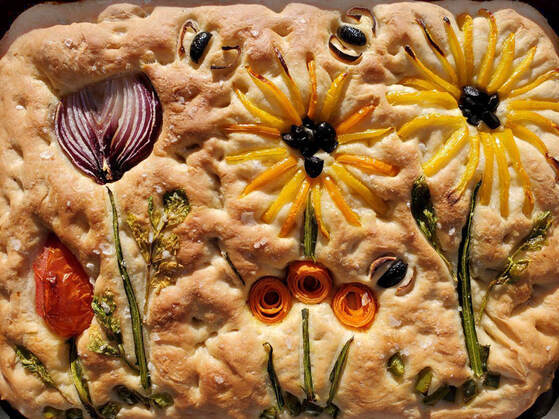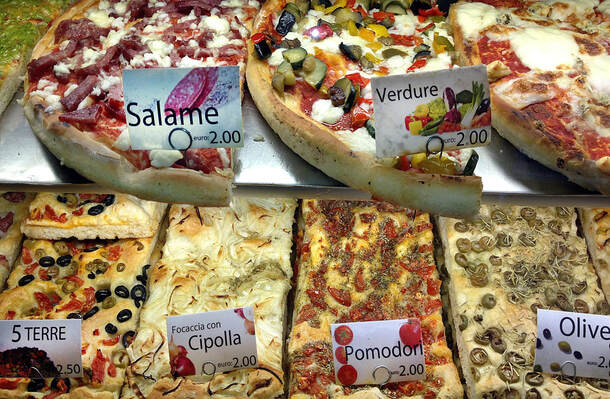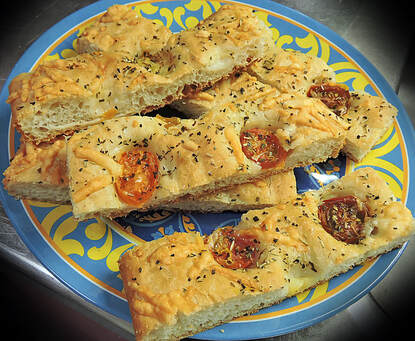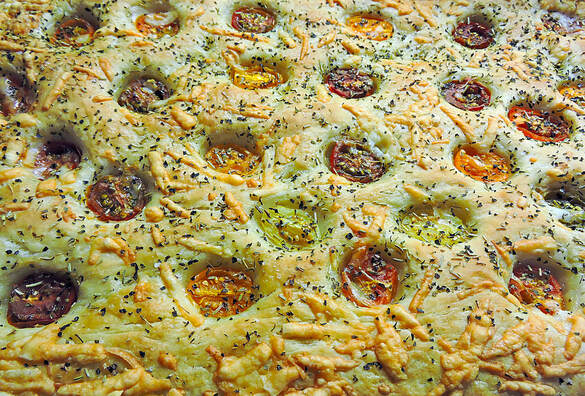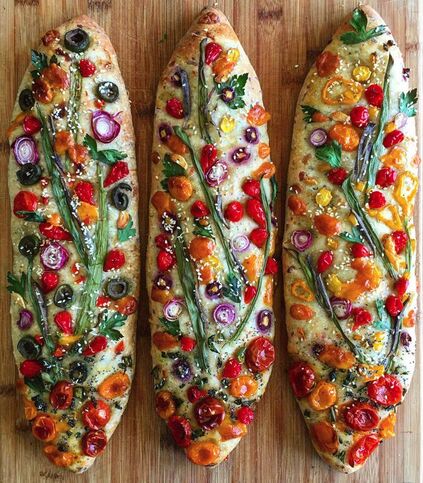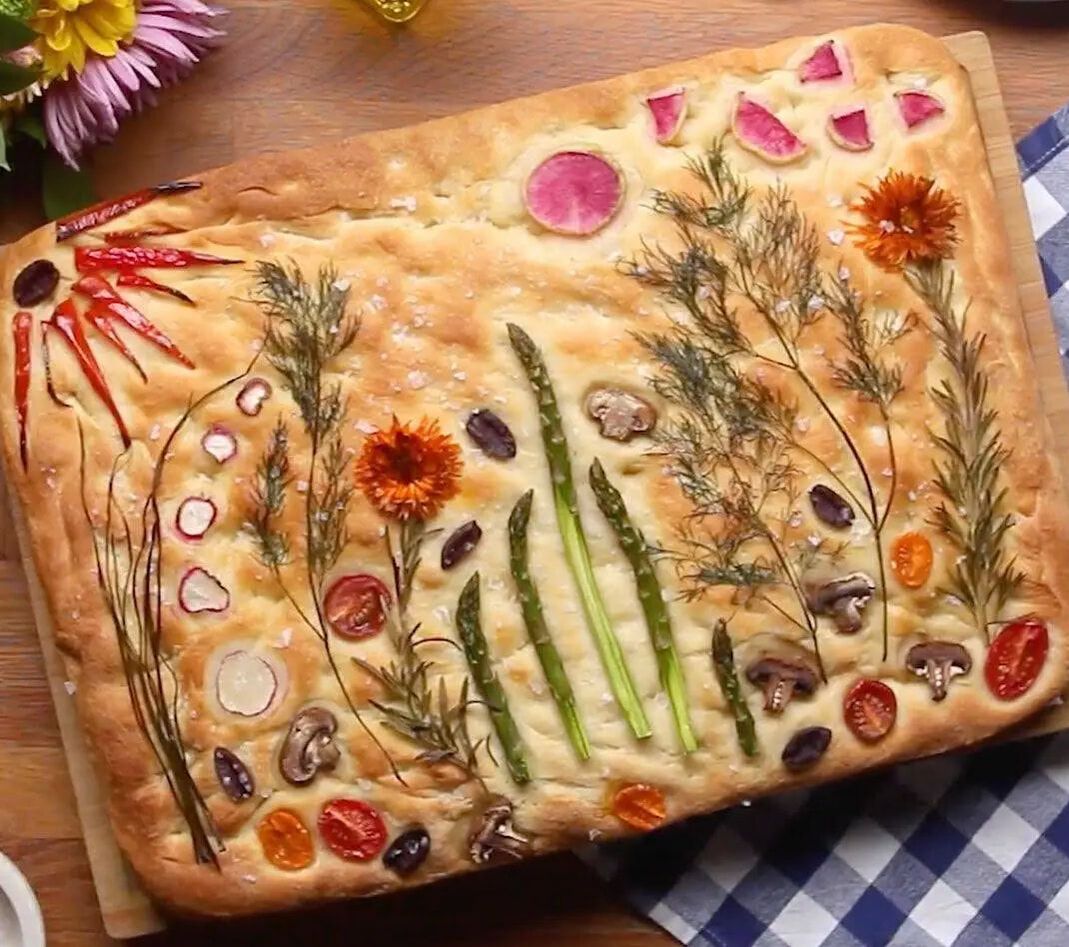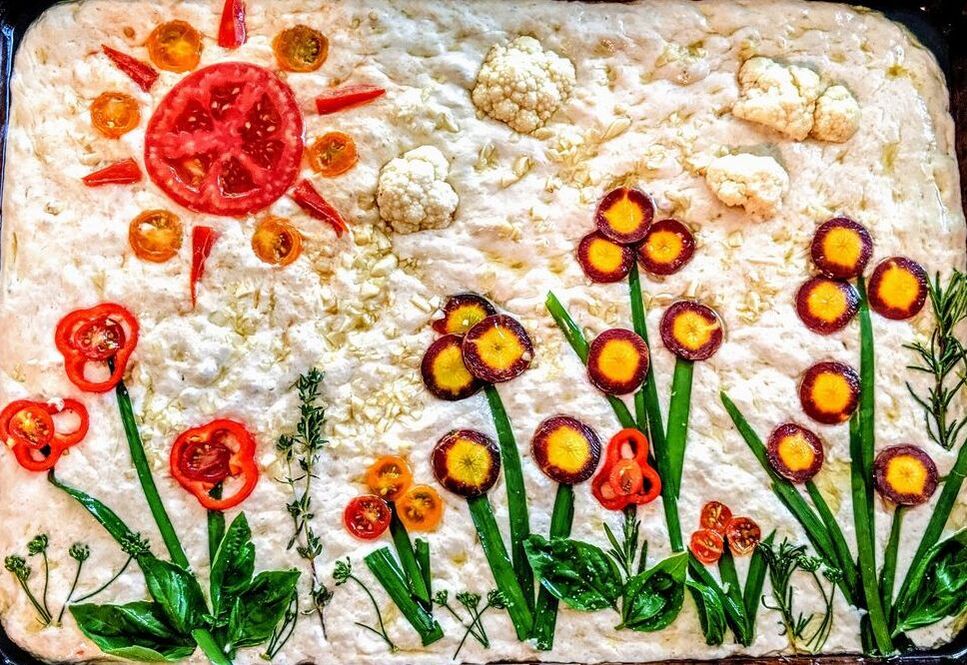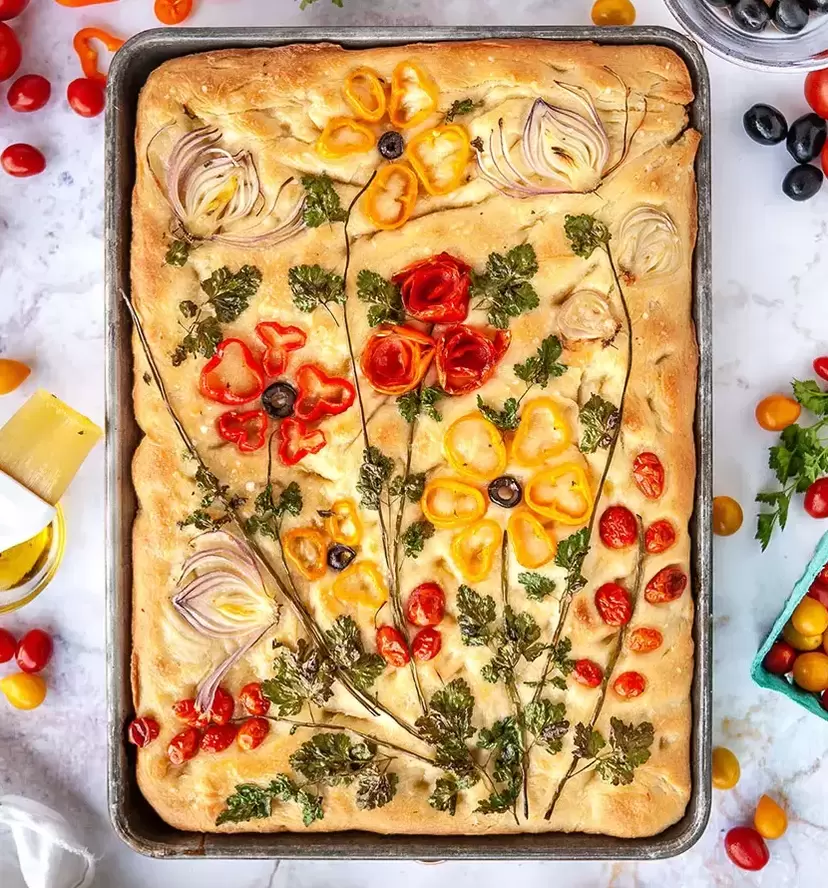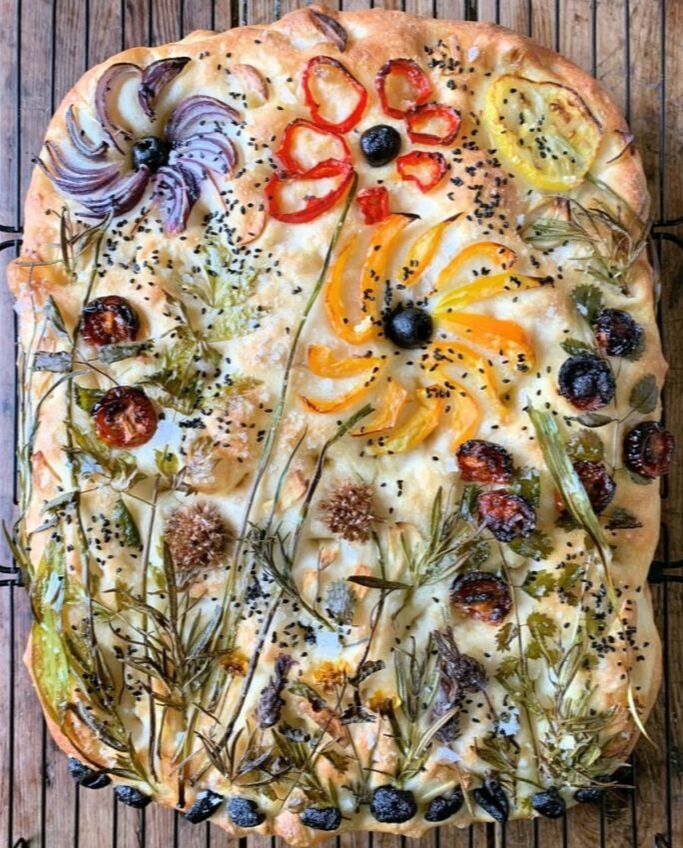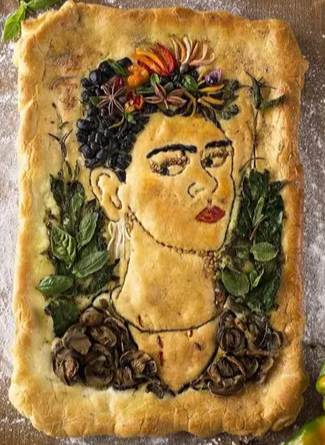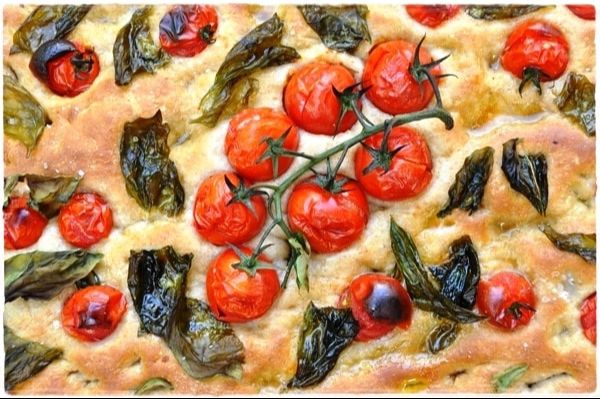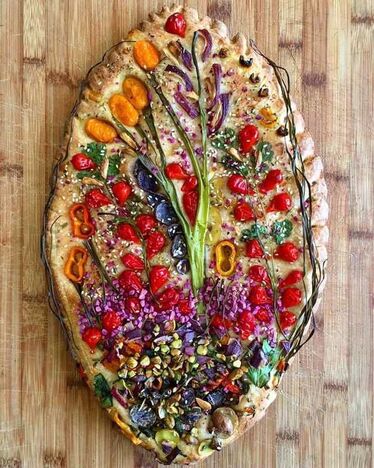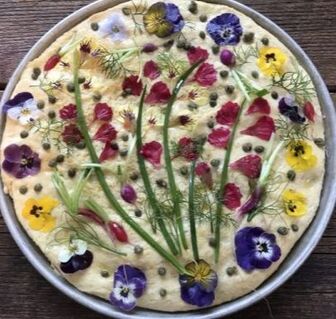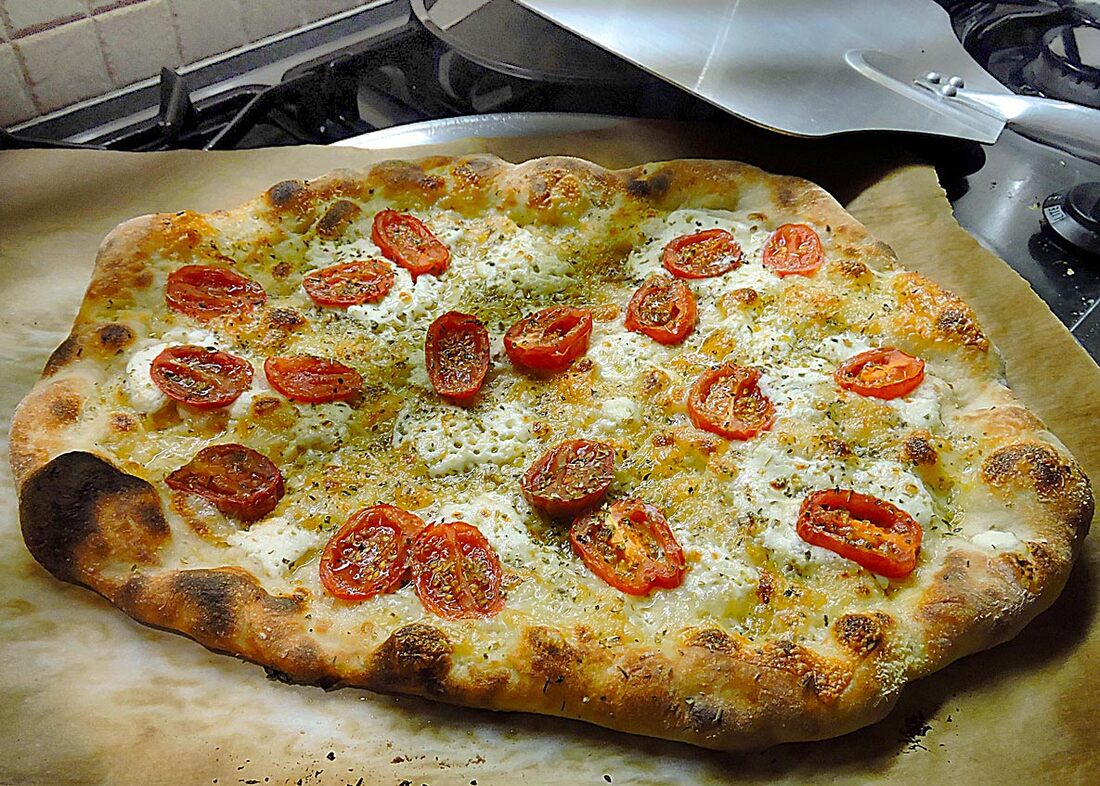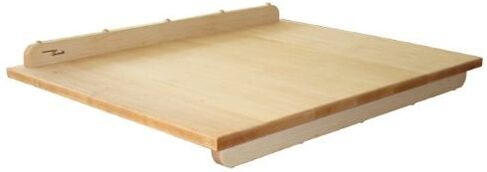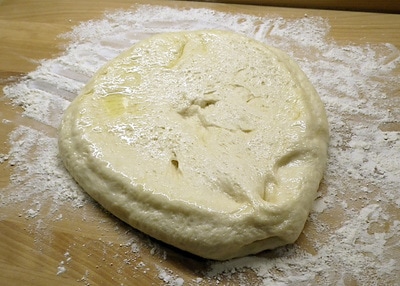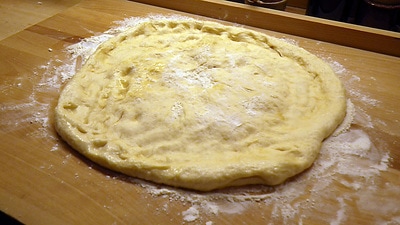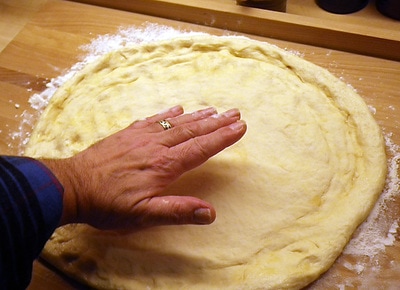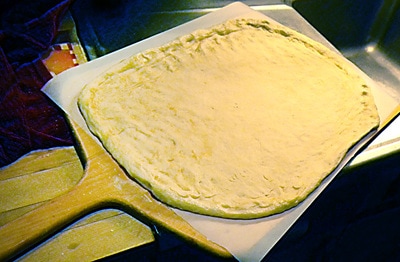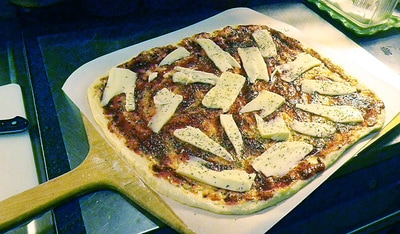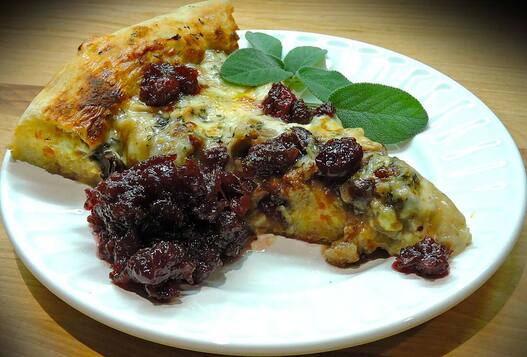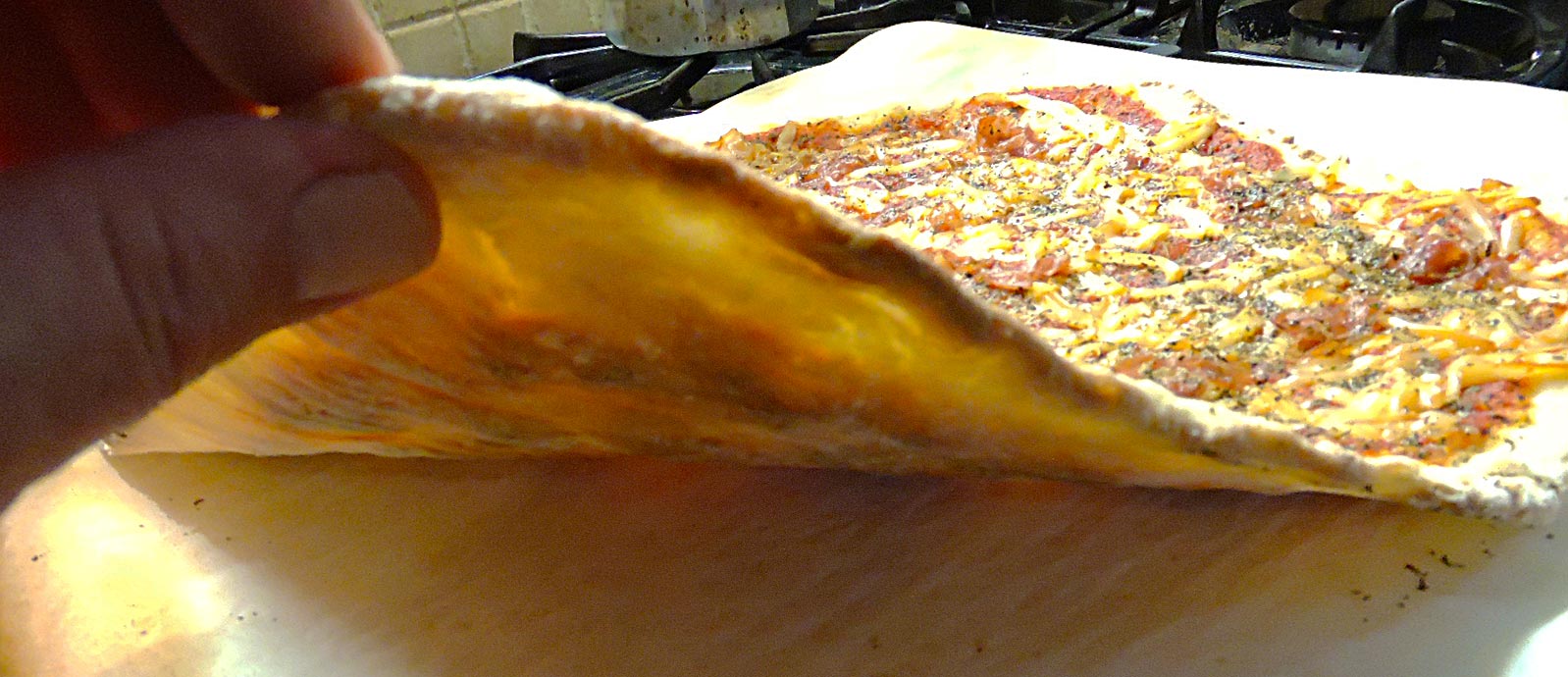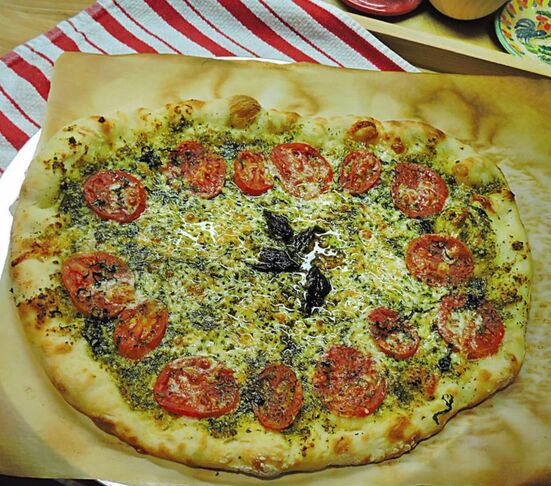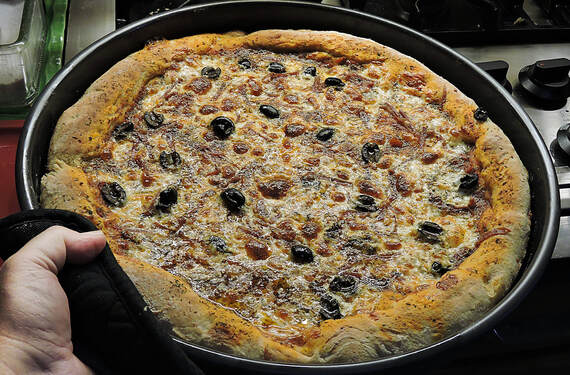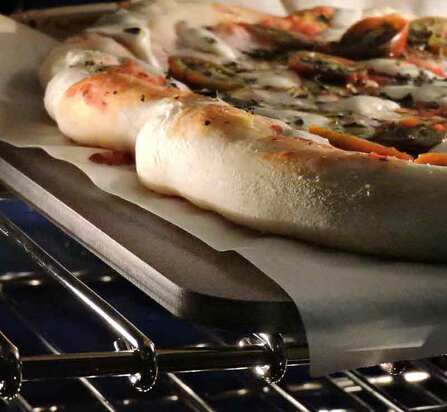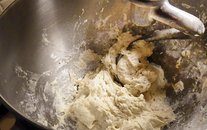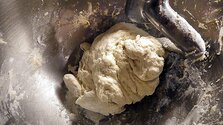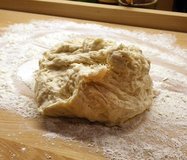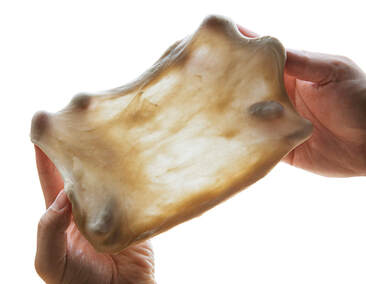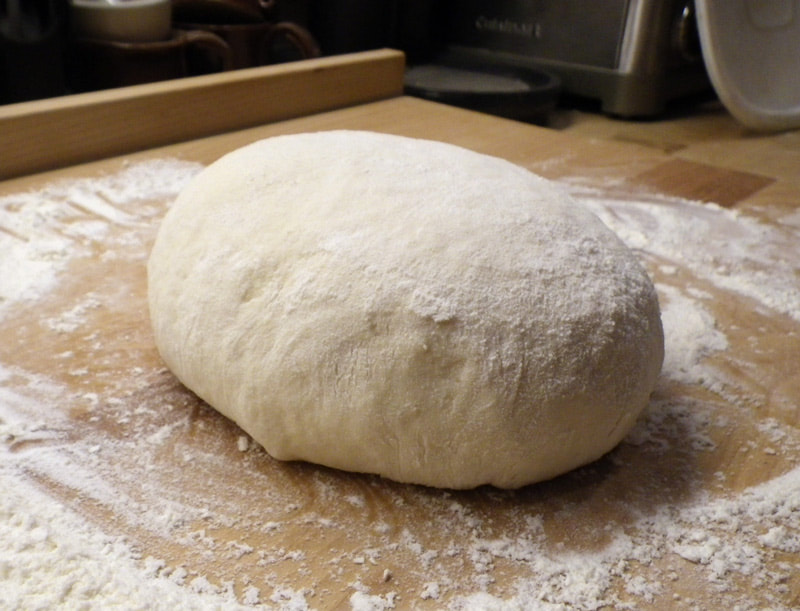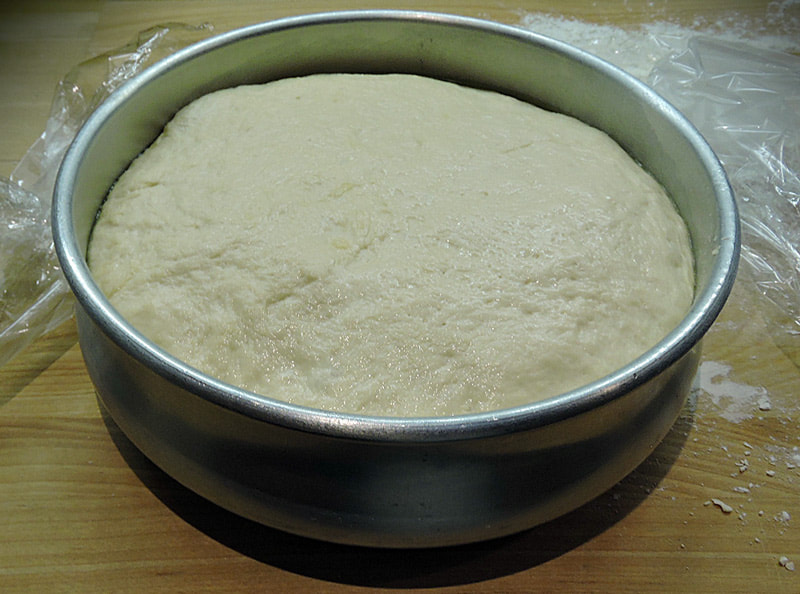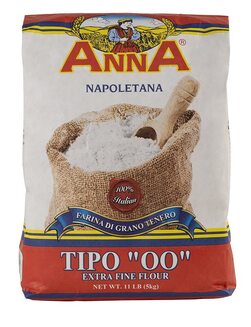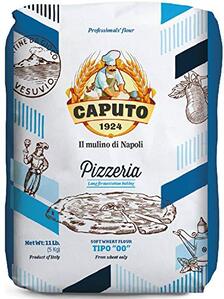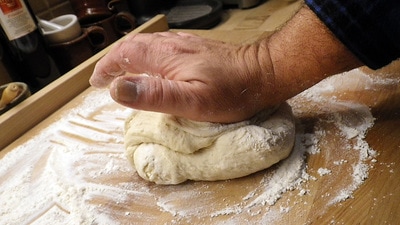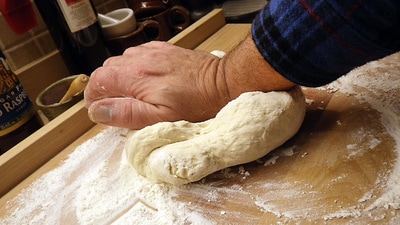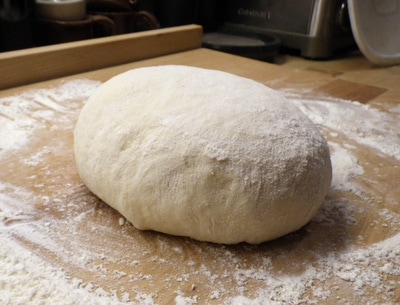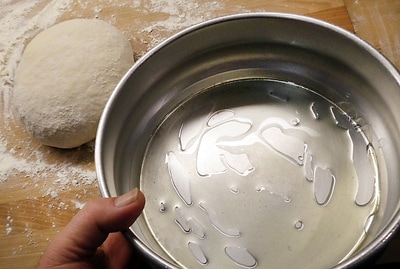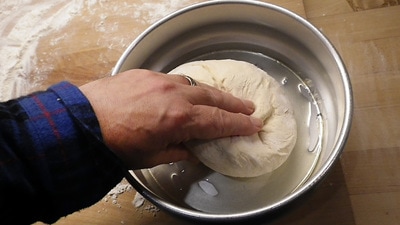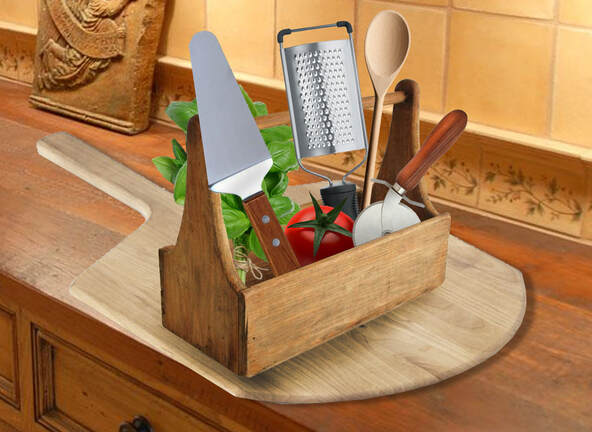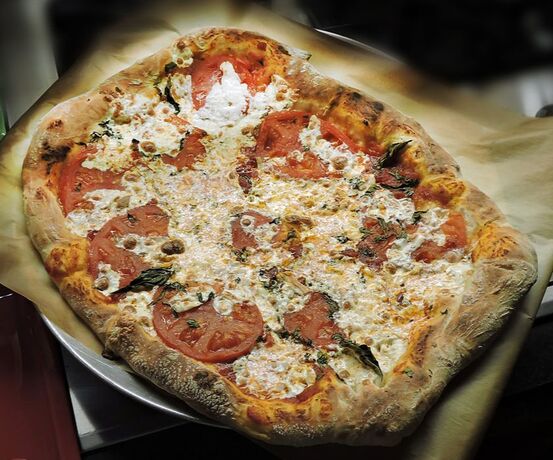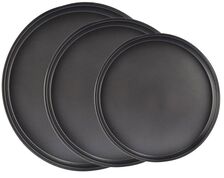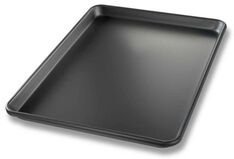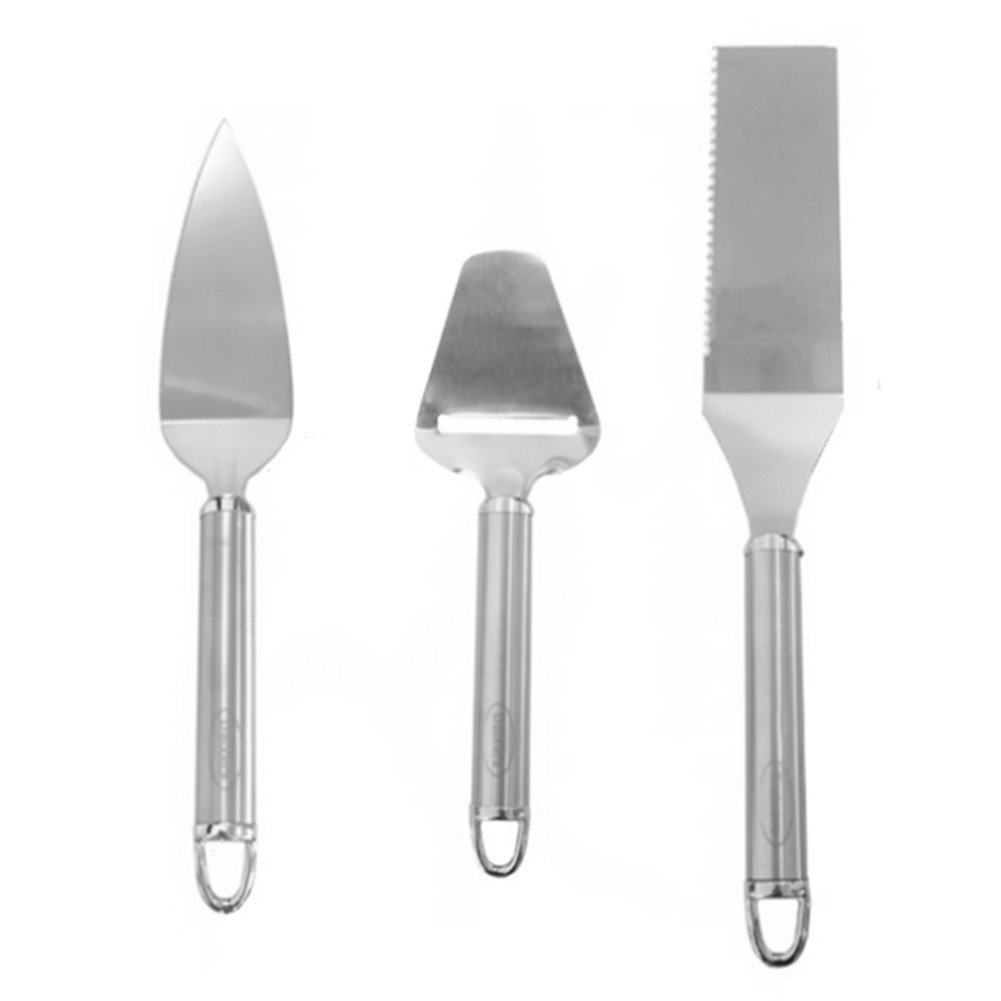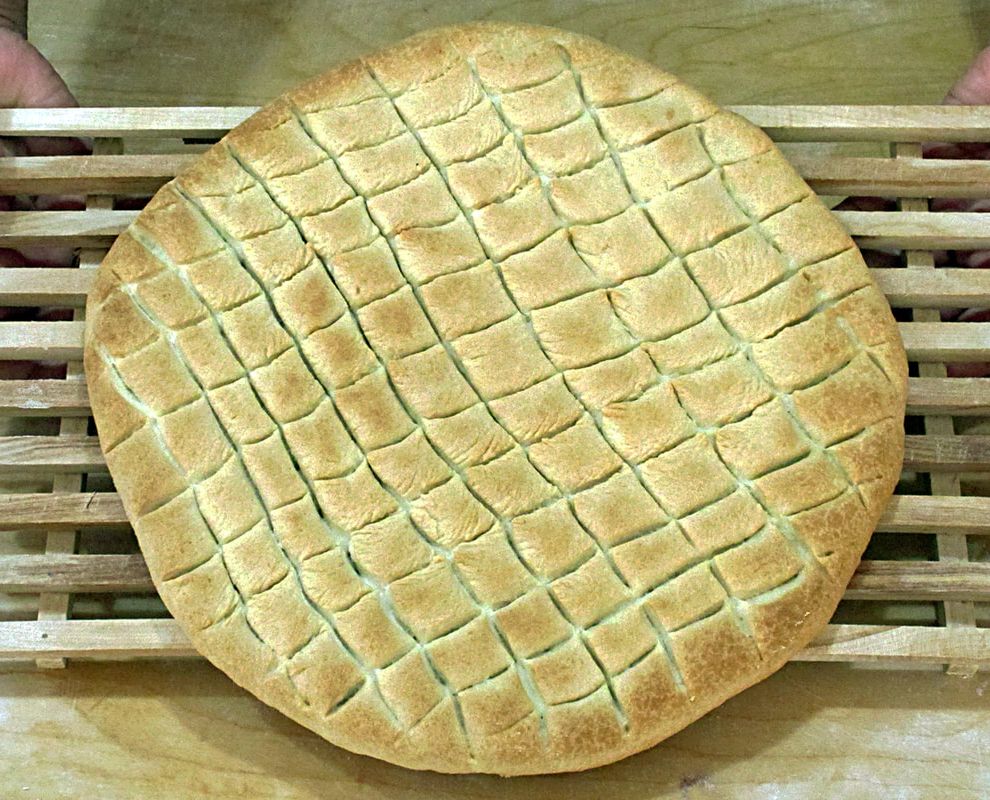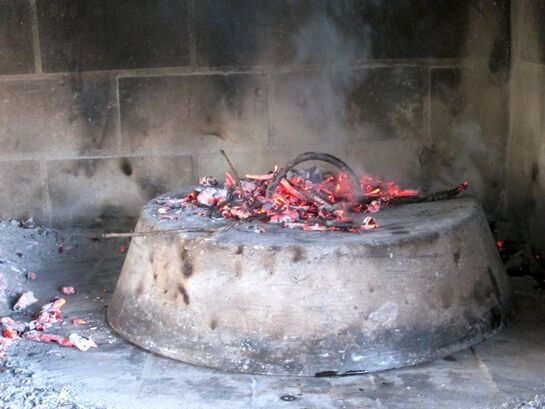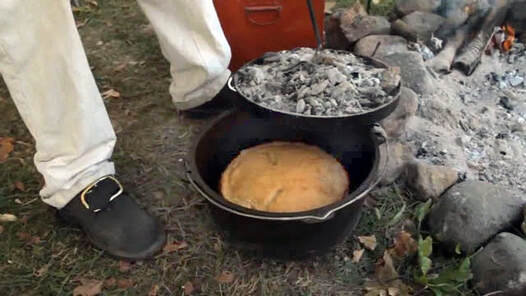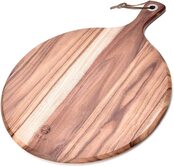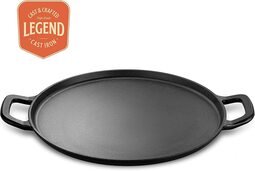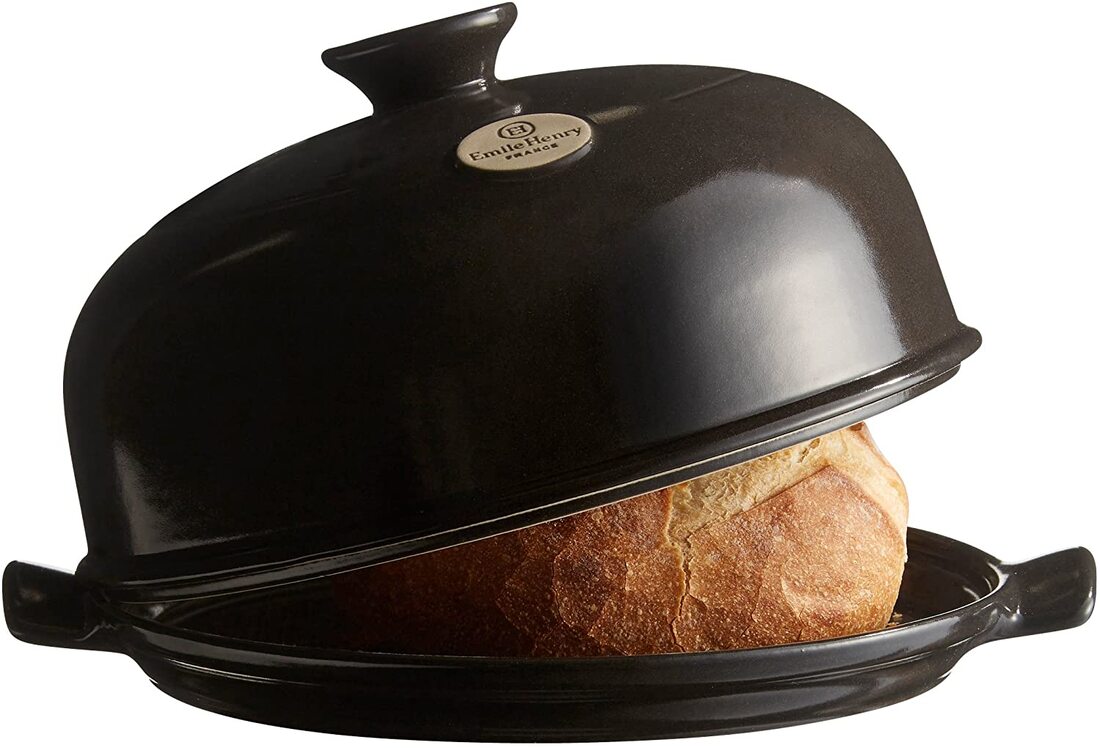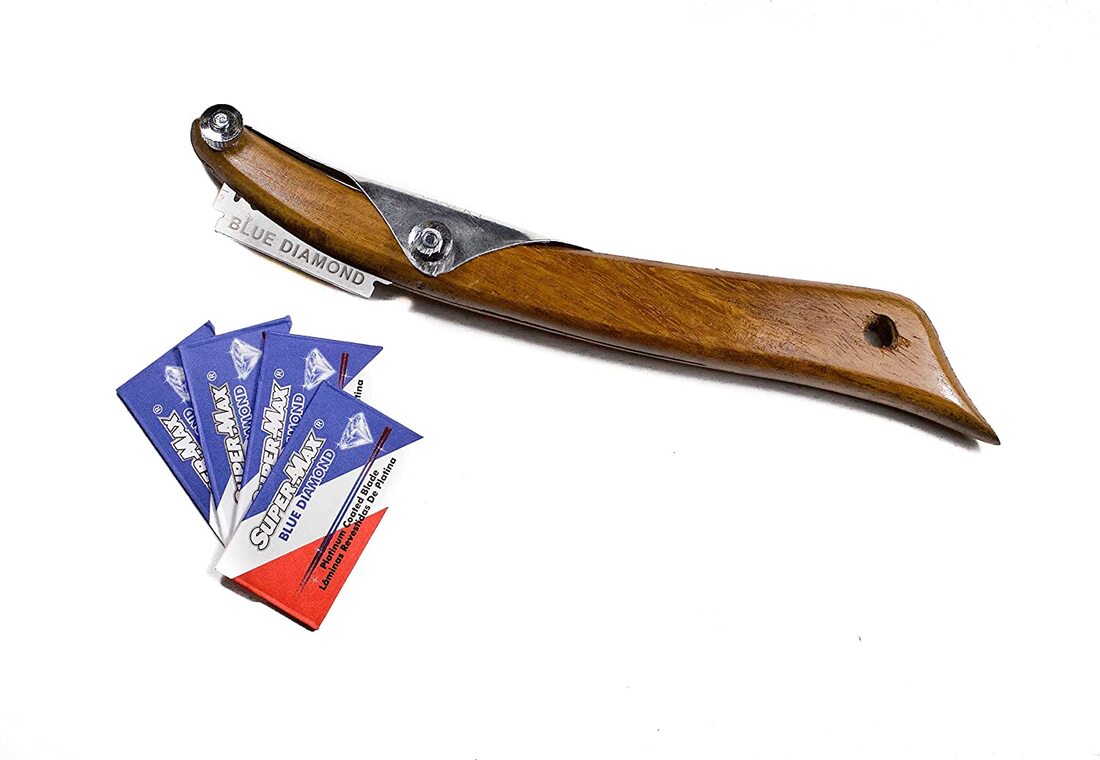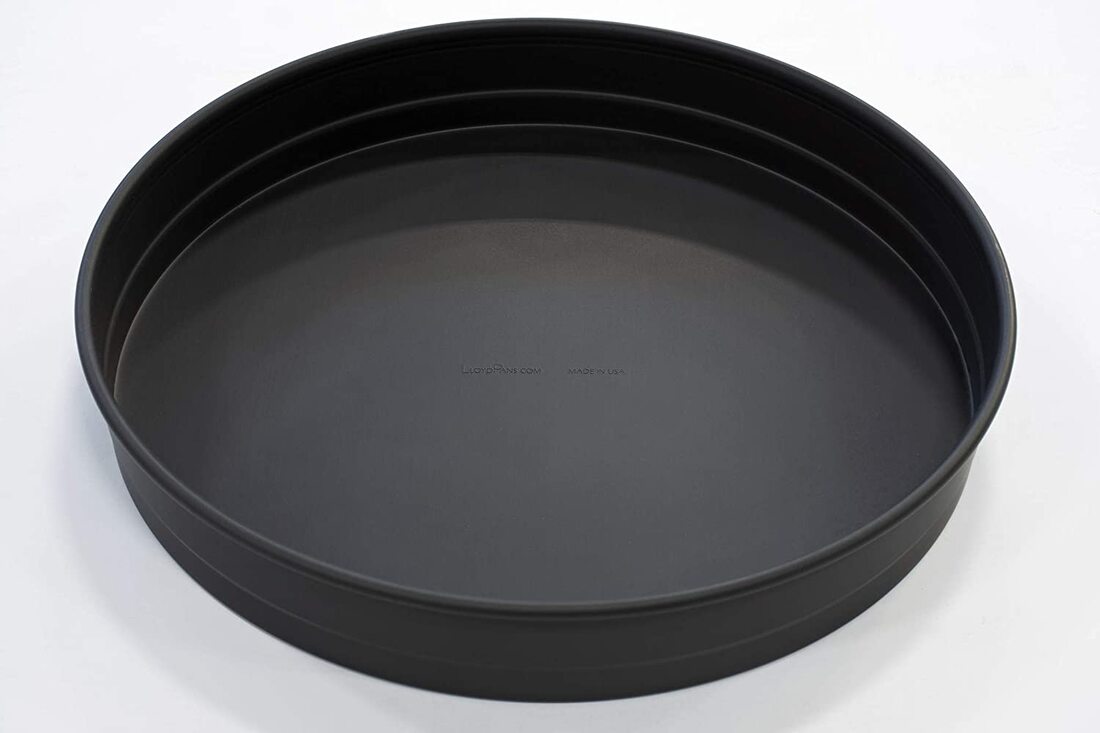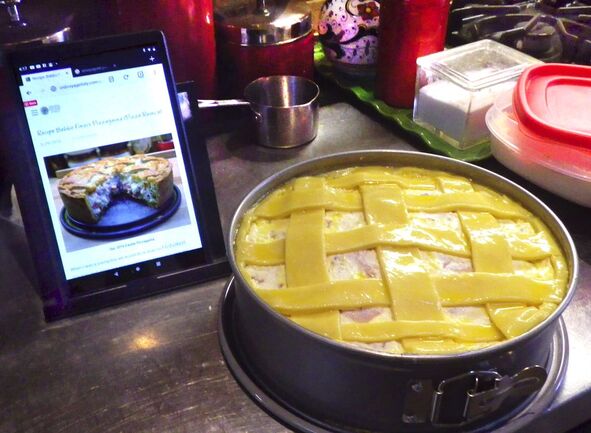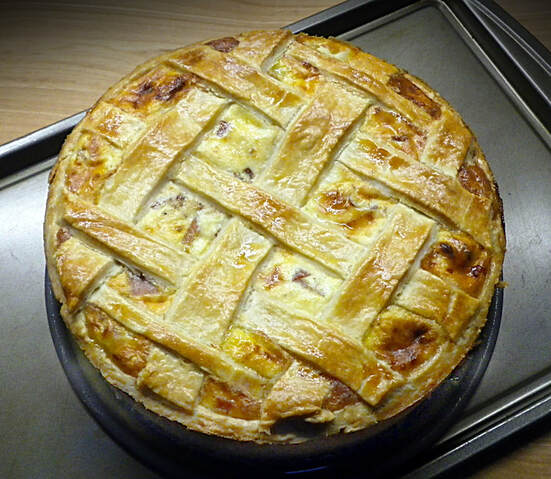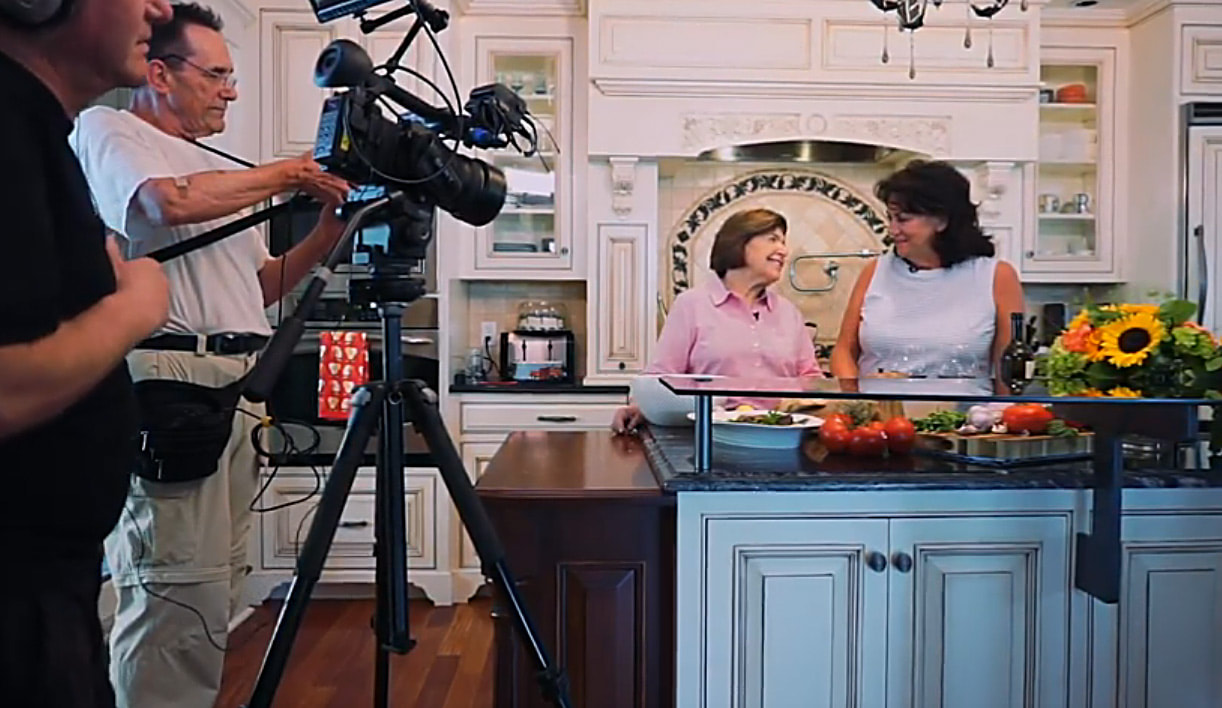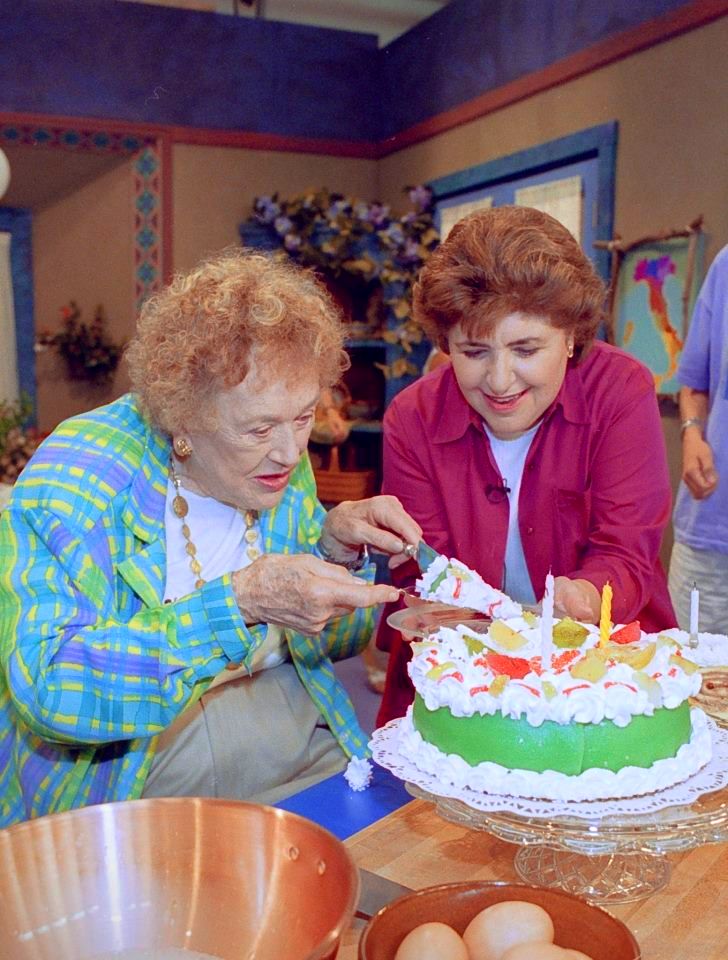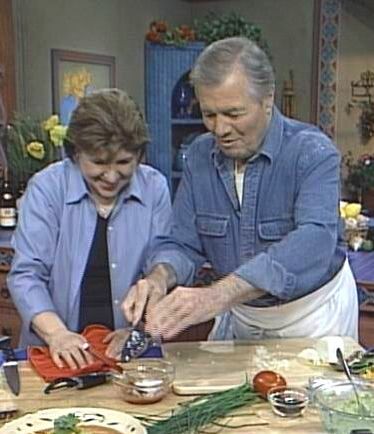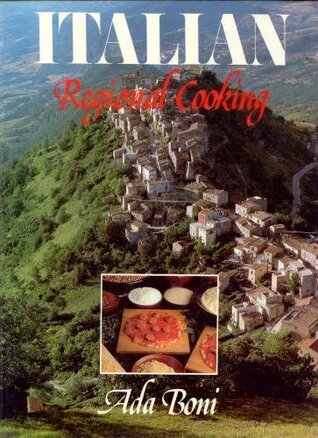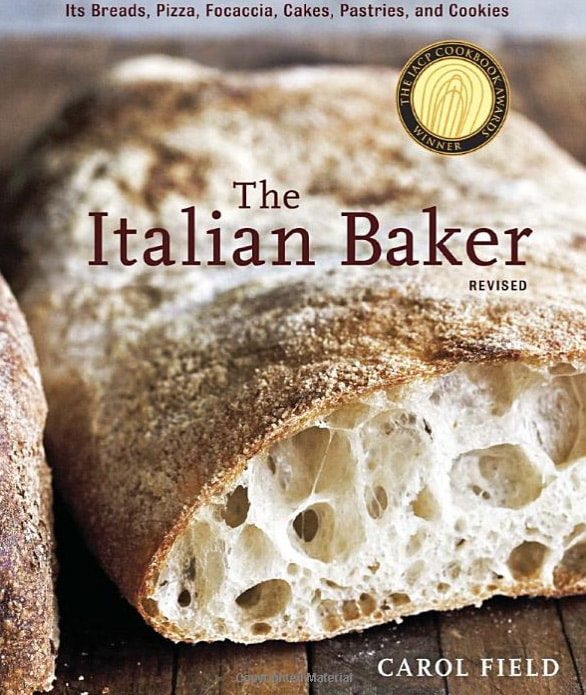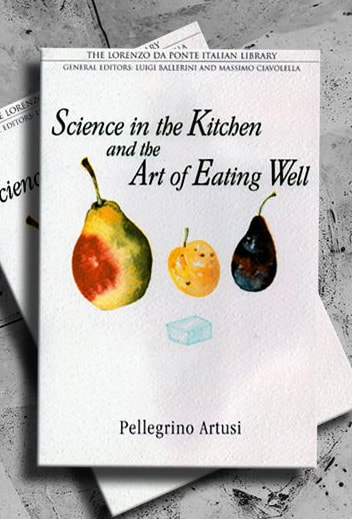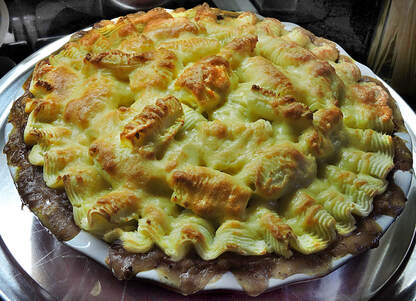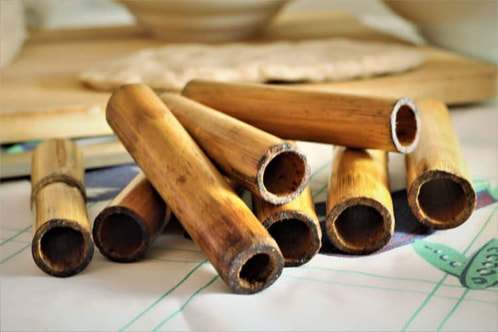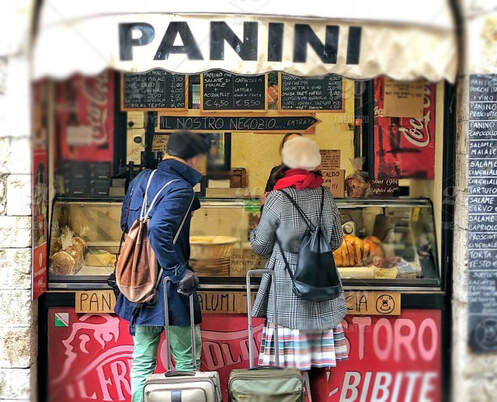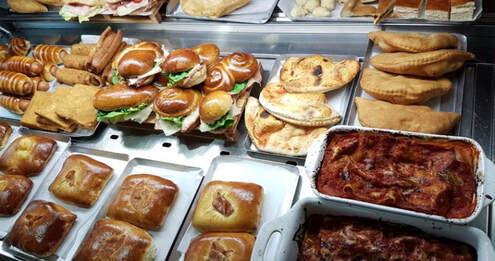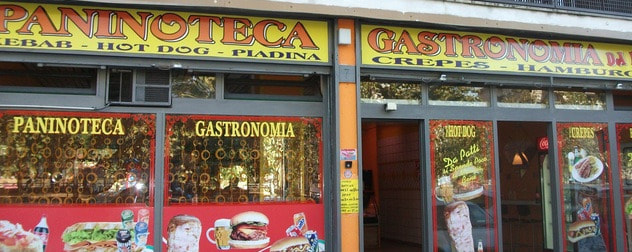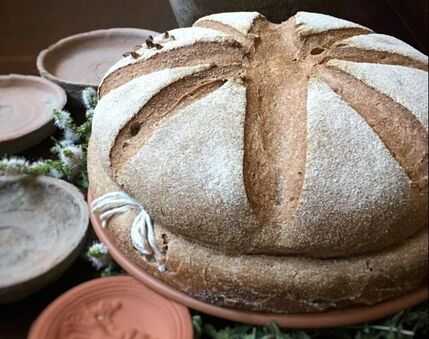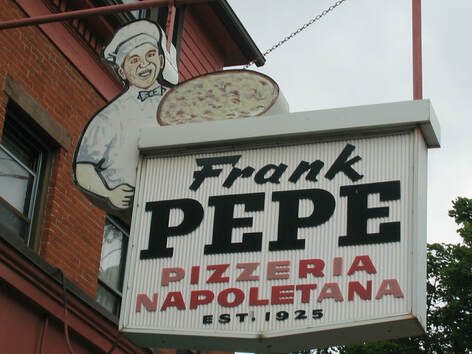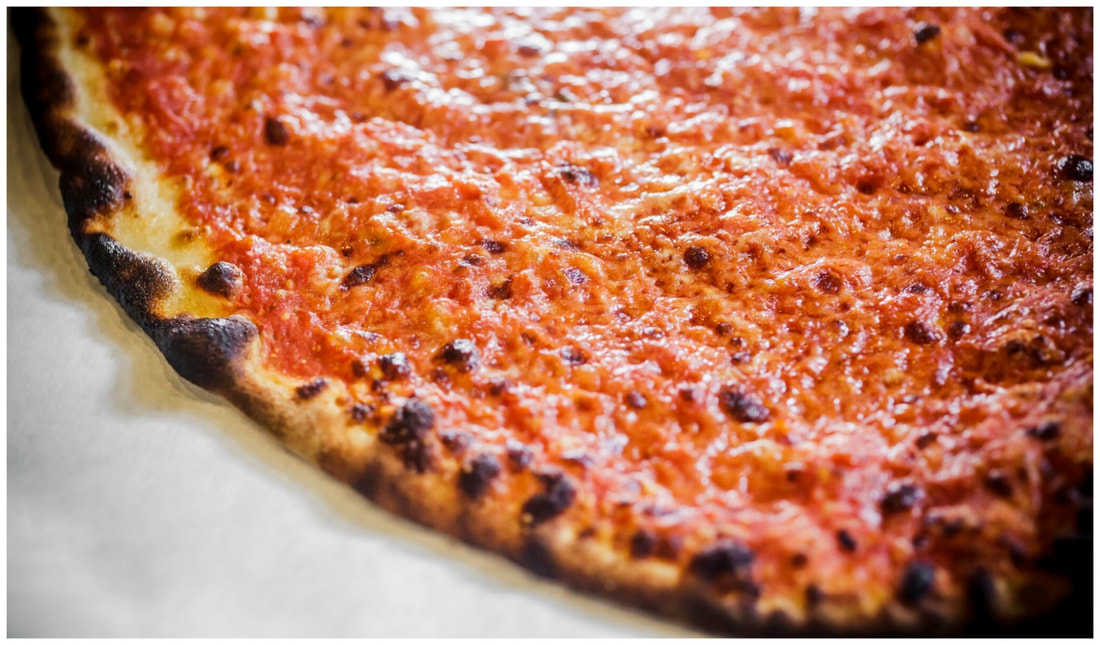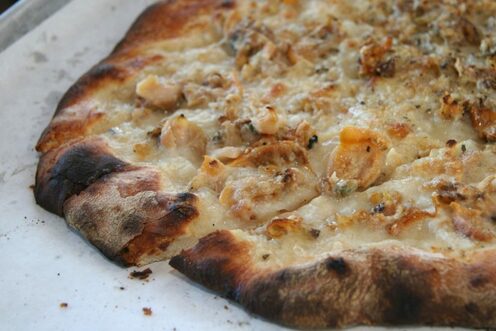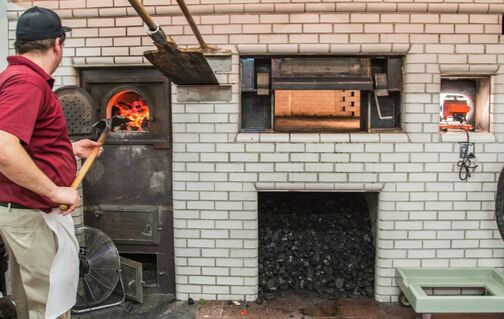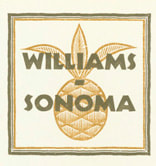|
Without a doubt, one of the best ways to discover truly authentic Italian recipes is to subscribe to Pasta Grammar's YouTube channel. Follow them on social media too... @PastaGrammer. You see, aside from the nonnas on the Pasta Grannies YouTube channel, this raven haired Calabrese, Eva is one of the best cooks who uses traditional techniques for traditional Italian dishes. Her recipe for ciabatta is one you'll want to make every week. --Jerry Finzi Focaccia is one of the world's oldest flatbreads with roots in ancient Greece and with the Etruscans, even before the Roman Empire reared its head. The Romans called it panis focacius (bread of the hearth) in Latin. In its basic form, it is a leavened bread, very similar to pizza but without all that cheese. There have been versions of focaccia all through the Mediterranean coastline in Europe and northern Africa. In ancient Roman days, it looked like a very simple, flat round of pull-apart bread. It was a meal to be carried by shepherds and fishermen and meant to be eaten later. In regions of neighboring France it's called fougasse. In Argentina and Brazil--both with large Italian immigrant populations--its name is fugazza and they can be either topped with stringy cheese or even double-crusted and stuffed. The common modern form of focaccia is dimpled with fingertips to make little wells that can hold savory items like olives, cherry tomatoes, peppers, red onion, sliced potatoes, garlic or even sweet things like figs, pear slices, blueberries, walnuts, dates, honey, anise seeds, bulbing fennel (finnocchio), orange zest or grapes. The top is usually brushed or drizzled with extra virgin olive oil and sprinkled with rosemary, sea salt, pepper or other spices. Of course, you can sprinkle a bit of cheese (usually grated), but go to far and you've crossed the line between focaccia and pizza. The variations are endless. In Italy, most pasticceria (pastry shops), panetteria (bread bakery) and even bars will have slices of focaccia often sliced and priced by weight. (Note: A "bar" in Italy is a family friendly place to get cappuccino and pastry in the morning and panini for lunch.) Focaccia is usually baked in 1" deep, dark steel pans. The texture is usually bready and for that reason a high protein "strong" flour (bread flour here in the U.S.) is used. The thickness also has the benefit of being used to make panini, slicing through the middle and stuffing with provolone, mozzarella, prosciutto or thing slices of salami. 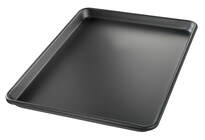 Dark, half sheet pan available on Amazon Dark, half sheet pan available on Amazon Ingredients Yeast mixture: 1-3/4 cups warm water (110-115F) 1-1/5 tablespoons fast acting yeast 1 tablespoon honey 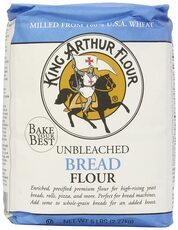 For the dough: 1 cup King Arthur all-purpose flour 2-3 cups King Arthur bread flour (plus extra bench flour) 1 tablespoon sugar 1 tablespoon sea salt 2 tablespoons extra virgin olive oil Extra virgin olive oil for the pan Toppings: Extra virgin olive oil (for brushing) Cherry tomatoes 1/4 cup grated cheese (using 1/4 holes/box grater), provolone, asiago, or caciocavallo (cheese is optional) Dried thyme, rosemary, oregano, fresh ground pepper, sea salt Directions Preheat oven to 435F with a pizza stone or steel on the center shelf.
You can reheat in a microwave by wrapping with a damp paper towel, then heating for 30 seconds (time depends on the power of your unit). To kick it up a notch, try a fresh drizzle of extra virgin olive oil (we really recommend unfiltered) or an aged balsamic. For a quick lunch, top with a draping of prosciutto. You can also slice focaccia in half and use to make a panino (sandwich) filled with thin sliced colt cuts and cheese or even cooked ingredients like grilled eggplant, tomatoes and mozzarella or roasted vegetables. Getting Creative Now that you know the basics of making focaccia, consider getting creative, as these examples illustrate. Look for color contrasts, textures and interesting shapes with your choice of toppings. Consider unusual things like asparagus, cauliflower, beets, basil, cilantro, kale, mushrooms, berries, capers, chives, colored course sea salt, and various seeds. Depending on your ingredients, you might have to partially bake your focaccia first with ingredients that can cook during the entire bake time and need to be pressed into the dough. For other things that might burn, like seeds or tender leaves like basil, position on top during later stages of baking. Be creative and make a masterpiece for a special occasion, or simply make simple focaccia for every day snacks and meals... Buon appetito! --Jerry Finzi You might also be interested in...
Forni Italiani: 21 Regional Breads from Italy The Secret Life of Ciabatta Scarpetta: Bread Wipes the Italian Plate Clean Italian Easter Bread: Pane di Pasqua Recipe Pane Coccoi: The Amazing Sardinian Art of Decorated Breads Forno Antico Santa Chiara: More than Just a Bread Bakery Forming and Topping your Pizza To use the dough, turn it out onto a floured surface and to shape your pizza. A larger recipe will make one large pizza, divide into two or more smaller balls to make individual pizzas. If you divide the dough, either do it before the rise (each one rising in separate bowls) or to save bowls, divide using a bench scraper, then fold and form the dough back into ball shapes. If they seem too elastic to form balls, let the dough rest a few minutes before shaping your dough balls. You can let your dough balls relax in the fridge, laid out on an oiled sheet pan and covered with plastic wrap or a floured kitchen towel before use. Take them out a few minutes before forming your pizzas. There are many ways to shape a pizza. If you want a really thin crust you can use a floured rolling pin--a simple log shaped one is best to ensure an even thickness. A tapered French pin will not roll out dough evenly. One of the easiest ways to form a pizza is to use all of your fingertips... pressing down and pushing out to flatten and then widen your dough into a round. To make it easier for you, you can shape your pizza on a sheet of parchment paper and then when done, slide your peel under the paper for topping off. I tend to shape it on a floured surface, then transfer by hand (draped over my floured forearms) onto my peel which has a sheet of parchment covering it. You can also transfer using a "booking" technique. Once you have your dough shaped on your work surface, get your peel ready, placing it next to your work surface with a sheet of parchment paper on top. To "book" your dough, lightly flour the top of the round, spreading the flour over the top with your hands. This will ensure the dough doesn't stick to itself when you start folding it over onto itself. You want to fold into thirds--the two side thirds fold in toward the center third. Fold one over the center first, then the other. Quickly (to prevent sticking), transfer to your peel and carefully unfold your dough round and adjust its shape. A more advanced technique is to shape your dough like pizzaioli do in Italy. Below is one of the most instructive videos I've found on this technique... A wood surface gives you "grip" for shaping pizza dough. Marble, granite or Formica surfaces can make the dough stick, so be liberal with bench flour while kneading and forming your artisinal dough. I use a bread board (like the one pictured above) that sits on top of your counter. Don't forget your best tools--hands. I mainly use my hands when shaping pizza. Since I'm really making a more delicate, artisanal style pizza dough, you really can't throw it like in a commercial pizzeria. First, make sure you have a decent amount of flour on the workbench. Now, toss more flour on top of the dough before you start. Basically, you want the dough to have enough flour under it to slide easily when working it. You also to flour your hands so your hands don't stick to the dough. Basically, I tend to leave a slight mound in the middle, then press with the sides of my hands to form a thicker crust edge (I like a thick crust on the perimeter of a pizza). Pat the middle with your flat hand, or use your finger tips (all of them) to push down the high spots of the dough until you make the diameter the size you need. As you press, push outward to where you need more width. If the dough won't move or slide, lift up and dust some more flour underneath. If you make a hole, tear a little dough off the side and patch it. If you aren't using the parchment paper underneath, gently lift one side of the dough round and lift it on top of your floured forearm. Then with the other hand, help to lift and slide it onto your pizza peel on top of the waiting parchment. Pull the edges of the dough to fill your peel or into a circle, whichever you prefer. Rustic shapes are fine too. By the way, instead of using parchment, you can also sprinkle a good amount of coarse corn meal on the peel and put the raw shaped pizza on top of that. The corn meal acts like little ball bearings making it easy to slide your pizza onto the stone. I've switched to using parchment simply because it's a bit neater... some corn meal winds up at the bottom of the oven and tends to burn, messing up both pizza stone and the oven. I never would recommend topping off the dough while it's still on the work counter. I've even seen TV chefs do this and then have some trouble when trying to slide a metal peel underneath, pulling and tugging the loaded, wet dough. Just have all your toppings ready beforehand, place your dough on your parchment lined peel, and top-away! You can use my Basic Pizza Sauce Recipe or any jar sauce, as long as it's not too thick. Pizza sauces tend to be on the watery side. (Click Here for our Basic Pizza Sauce Recipe.) As for cheese, while most home pizza makers will use supermarket mozzarella, don't forget to try others: Sharp provolone, burrata, Italian Fontina, smoked or fresh mozzarella, buffalo mozzarella, bocconcini, mascarpone, ricotta, ricotta salata (or feta), Gorgonzola, cacciacavalo (our favorite sheep cheese), asiago, Parmigiano reggiano or formaggio fresco (called basket cheese in some Italian neighborhoods). Depending on the type of cheese, it can be sliced, diced, grated or simply dolloped on top of your pizza. With mozzarella, cut it into thin slices with a knife or grate it with the 1/4 inch holes on a typical cheese grater. Mozzarella is easier to grate if you place it in the freezer for 15 minutes first. When using fresh mozzarella, try pinching off rough pieces and dropping them randomly on your crust. You might even try partially baking your crust first and then adding cheese and toppings for the final few minutes of baking. This is a method used in Italy when using very fresh cheeses like buffalo mozzarella, fresh ricotta or burrata. As for the rest, live it up and experiment. If you want a simple Pizza Margherita, all you need is sauce, basil leaves and some mozzarella, with perhaps a drizzle of extra virgin olive oil and sprinkle of oregano (we grow our own in summer). We love olives (buy pitted and just squish them in your fingers and drop them on), smoked or Virginia ham, prosciutto, speck (Italian smoke-cured prosciutto), leftover bacon from Sunday breakfast, paper thin (cut on my mandoline) slices of dry sausage or zucchini, caramelized onions, fresh heirloom tomatoes, smoked turkey, home made meatballs... whatever suits your taste. After Thanksgiving we use leftovers for a Thanksgiving Day Pizza--turkey, stuffing, cheesy mashed potatoes, fresh cranberries and for the sauce, turkey gravy. Recently, I even made a Chicken Marsala pizza. Lisa likes a white pizza--easy to do (without red sauce), smeared with ricotta cheese (she makes it fresh) and drizzled with olive oil finished with grated Romano and oregano. TIP: Don't let your topped off pizza sit too long on the peel. Get it in the oven quickly or it could stick to your parchment or peel (making it difficult to slide off into the oven), or the wet ingredients might soak too far into the dough. After you've topped it off, slide it into your oven onto your preheated stone/steel. Place the leading edge of the peel about 1" from the rear edge of your steel, then give a gentle slide at first to touch the rear edge of pizza onto the surface. Next, give a quick thrust backwards, pulling your peel out from under your pizza. This should land the pizza perfectly, but practice carefully at first. Just be careful not to allow the edge of the pizza to droop over the edge of your stone! True confession... when rushing one Saturday night to get my pizza into the oven, I swung the oven door open, slipped it from the peel into the oven and suddenly realized I forgot to put the steel into the oven! With the help of my metal peel and a large metal spatula, I managed to get it out, folded it into a pan and made a fairly presentable stromboli. Dinner saved! If your oven is around 510-515 degrees a pizza should cook between 3 and 5 minutes. You can try using a higher temperature (my oven goes to 550F) but that might cook the bottom crust before the toppings. Use a metal spatula or peel to check under your crust to make sure it's browned. (The sugar added to the dough aids browning). After the timer goes off, use the peel to slide under the parchment and pizza (or your pan pizza), lifting out and transferring to a wooden serving board or serving pan. Use a pizza wheel shears to cut your slices. If you've made thin crust individual pizzas, place them directly on large plates and eat them Napoletano style... either with a knife and fork, or da portare via (take out) style and fold them in half or quarters and eat it like a sandwich. The world is your pizza, when you just stop and think about it... but, don't stop... make pizza!
--Jerry Finzi, la Pizzaiolo di Famiglia Finzi If you enjoyed this article, please SHARE it with your friends on Social Media. Grazie! Now that you've gathered together a basic pizza making toolkit, let's start actually making one... My "Measure Water First" Method First, I'd like to explain my basic concept that I've developed over the years. Most pizza dough recipes will give you precise measurements for flour in either cups (in the U.S.) or by weight (Europe). I don't really measure flour. Instead, I focus on measuring the water, depending on the type of pizza, style or size that I'm making, and then judging the look and feel of the dough as more flour is added while mixing or kneading. You can and should learn what a good dough for a particular type of pizza should look like. Making any type of dough for bread, pizza or even pasta is not precise like pastry or cake recipes. It's all about the look and feel. There are many advanced pizzaiolo's recipes as ratios by weight of all ingredients, especially the ratio of flour to flour. They talk in terms of "60% hydration", sometimes more, sometimes less. This is true, but it's a complex, fussy method for beginners who just want to learn how to make great pizzas easily. Still, they are correct in that the hydration of a particular dough gives each type of pizza its unique characteristics. Hydration also governs how light and airy a crust can be--or how dense. Of course, as you get more advanced you'll learn that other things also contribute to each type of crust: mixing types of flour; using honey versus sugar; using salt or not; olive oil or not; and how long and how many rises the dough is given. Often a subtle change makes a big difference in texture, taste and structure. Water & Yeast The first thing I do is place warm water (110-115 F) into a glass measuring cup, and ensure the measurement is correct for the size and type of pizza I'm making. For example: 1 - 1/4 cups water for a 12"-14", basic pizza, baked on parchment, on stone or steel. 1 - 1/2 cups water for a 14-16" basic pizza, either on stone or in large pan. 1 - 3/4 cups water for half sheet pan focaccia or "Grandma's Pizza", or 2-4 personal pizzas. For now all you have to learn is how your dough should look in the mixing bowl. Some basic things to look for in the bowl of a stand mixer after adding the first 1 -1/2 cups of flour and pouring in the water/yeast mixture:
So, if you understand my method, the water measurement is critical for the type/size pizza being made, but the amount of flour added will always vary depending on if it's a rainy day, if it's in the middle of a hot humid, summer's day, or if it's the middle of a dry winter with your heat drying out the air in your house. Remember, you can't remove flour if you add too much. Add flour slowly and use your eyes to see when it's getting thick like a pliant, damp, sticky putty... but NOT as dry as a child's Play Dough. If you add too much flour, your pizza will be dense and heavy. When a dough is dense, it makes it difficult for the yeast's gasses to lift and rise the dough--in other words, if there are no air spaces, all you have is a dense bread. 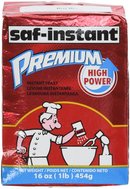 Ingredients for Three Types of Pizza Dough Proofing the Yeast For a 12-14" pizza... 1 - 1/4 cups warm water (about 115 degrees F) 1 packet "instant" yeast (or 1 tablespoon packaged/dry yeast) 1 tablespoon honey or sugar Use 1 to 1-1/2 cups All-Purpose flour to start, then use Bread Flour for the rest. Proofing the Yeast For a 14-16" focaccia or pan pizza... 1 - 3/4 cups warm water (about 115 degrees F) 1 heaping tablespoon packaged/dry yeast 1 tablespoon honey or sugar Use only Bread flour. Proofing the Yeast For a 3-4 individual, thin crust pizzas... 1 - 1/2 cups warm water (about 115 degrees F) 1/2 tablespoon dry yeast 1 tablespoon honey Use only All-Purpose flour. Proofing the Yeast 2 Neapolitan style, individual pizzas... 1 - 1/4 cups warm water (about 115 degrees F) 1/2 tablespoons packaged/dry yeast 1 tablespoon honey Use only Italian style "00" Flour. 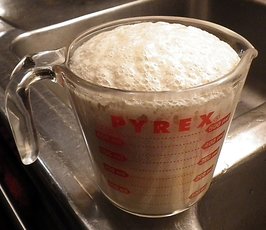 Mix the yeast and honey (or sugar) with the warm (115 degrees F) water in a medium size measuring cup. Set aside for 10-15 minutes to "proof" (foam up). If the yeast doesn't show "proof" that your yeast is alive and growing, you should shouldn't use it. Yeast should be alive. To understand what's going on, the honey (or sugar) feeds the yeast and as it grows, it produces gasses that will lift the dough. After you make your dough, the yeast is still working during any successive rise periods and and will lift the dough (puff it up). Pizza dough is a leavened crust (more akin to bread). A dough without yeast (or less yeast) makes more of an unleavened bread--like a cracker. If you want a bread-like dough (focaccia, sfincione or Grandma's style) use more yeast. If you want a thin, crusty pizza, use less. TIP: In case you don't have a thermometer, here's a method I've come up with to ensure the water is the right temperature... Turn your water on HOT and then try to hold the inside of your wrist in the stream of water coming from the faucet. At first it'll be way to hot to hold it for even a second. Start turning down the temp (add cold or turn the valve toward the cold side if it's a mixer valve) and try holding your wrist there again. When you can comfortably hold your wrist in the stream of hot water, it's hot enough without being too hot, killing your yeast. I've tested this method with a thermometer and it usually lands me around 110-115 degrees F. Preheating the Oven, Pizza Stone, Temps and Times First, place your pizza stone/steel in the oven on the center rack, and preheat your oven. For a basic pizza baked directly on the stone/steel, set your oven to 515 F and preheat for 30 minutes/stone, 60 minutes/steel. This pizza should bake within 3-6 minutes, depending on your home oven. Do not use convection! If the toppings need a more time than the bottom, place the oven to Broil for 1 more minute. Thin crust and Neapolitan style pizzas should also be baked at 515F. For pan pizzas, the rule is low and slow... less heat, more time. Preheat your oven & stone/steel to 425-435 F. Most pan pizzas in dark, heavy pans should bake in about 15 minutes. Ingredients for the Dough 1-1/2 cups all-purpose flour (all-purpose is needed to create a more crisp crust) 1 - cup bread flour (bread flour makes pizza more bread-like, I recommend King Arthur's) 1 - tablespoon sugar 1 - teaspoon salt 1- tablespoon extra virgin olive oil 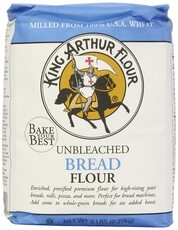 Making the Dough
The photo on the left needs more flour but is almost there. The center one has the right amount of flour--it's still a bit sticky. The third shows the dough as it looks on the bench before kneading. After kneading, you can do a "window" test as in the above photo. Stretch the dough until it gets paper thin and translucent without tearing. If it tears easily, there isn't enough gluten development. TIPS: You want to mix the dough until it separates from the bowl--but it should still be a bit sticky. Go slow with adding more flour. A dough that's too dry will make a tough, leathery crust. You want it soft and a bit sticky. One more tip... I use mainly King Arthur's flours for my pizzas. I've done tests using others like Gold Medal or Pillsbury and never got good results. The protein level of King Arthur's is higher, resulting in better gluten development. For Neapolitan style, I'll use 00 type flour (doppio zero, double zero), either Caputo or Anna brand. How much flour to add really depends on the humidity... on a rainy you might have to add more flour, while on a dry winter day you would add less. Making pizza dough, or bread for that matter, is a "feel" craft. It's not as precise as cake or pastry baking.You really have to learn the "feel" of a dough that works well for you. This will come with time and after having made many pizzas. Learn to recognize the stages: wet (not ready), very sticky (almost there), a little bit sticky (best), too dry or rubbery (you've added too much flour). Just remember that you can always add more flour, but you can't take it out once you've added too much. Go easy on adding flour toward the end of mixing. You can always add a bit more when it's on the work table. 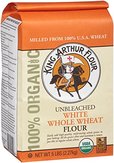 Why Mix Different Flours? When using bread flour, the body of the pizza softer, breadier and heavier--more like a focaccia or a deep dish pan pizza, but the crust bottom might be too light. Adding some all-purpose flour makes a barker bottom crust. If you use only all-purpose flour, it will be leaner, thinner and often crustier--as with a thin crust pizza. I find using both types is a good compromise between the two types for most pizzas I make. Experimenting with this ratio is a good way to learn how to control what type of crust you need. After gaining experience, you'll experiment with adding 1 cup of whole wheat flour, rye, corn flour or even buckwheat into the mix. However, if you use only a heavy flour, like wheat, your pizza will be tough and leathery and hard to roll out. I tend to use all bread flour or bread flour mixed with wheat or rye flours when I do pan pizzas, Chicago style and focaccia This gives a thicker, more luscious bready texture. When adding heavier flours (like wheat), I also tend to add a touch more yeast to help rise the heavier dough. Use less yeast with a bread-wheat flour mix and you can have a thin wheat pizza crust. Kneading the Dough Turn the dough out onto a floured surface and knead by hand. Flour both your hands and flour the top of the dough on the board. Fold the dough over toward you, push forward with the heel of your hand, then turn 1/4 turn and keep repeating until the dough looks smooth, soft and slowly bounces back when you stick it with your thumb.
Some say you must knead the dough for 5 or even 10 minutes or more, but I think this produces too much stringy gluten--the glue in dough--and can cause the dough to be tough. Gluten development happens even without much kneading. Besides, I'd rather be eating my pizza sooner rather than later. Tuck in or pinch together the bottom of your dough round and shape into a flat, round shape, then put it in the oiled bowl to rise. Oil both sides of the dough. Cover the bowl with plastic wrap and let it rise at room temperature for 45 minutes. On dry days, I usually help along the humidity a bit and lay a damp paper towel on top of the plastic wrap. You could even use a damp cotton chef's towel. There are two ways to proceed now. One is the quick way--a single rise--the other is longer... a double rise. Typically, for our weekly, Saturday night pizza, I'll do a short, single rise, unless I'm trying something a bit different:
If I'm trying to make a special artisan pizza or focaccia recipe I'll do a double rise:
The longer the rise, the more complex flavor develops in the crust... something I think is unnecessary for a quick "get dinner on the table" pizza. But if you like to experiment, let your dough rise overnight before making pizza. A longer, cold rise will develop better flavor! --Jerry Finzi When I starting making pizza about 20 years ago, I made a lot of terrible pies... doughy, pale-looking, tasteless, flat, oily, floppy, burnt--you name it. Lots of mistakes. But that's the part of life I love--learning from our mistakes and really fine-tuning a craft, talent or skill. You have to crawl before you walk or run. On guitar, one must pluck before you strum and then learn chord changes before making really beautiful music. On my penny whistle, I squealed like a pig before I could play a tune that my wife wanted to sit and listen to. My love of carpentry started when I was 5 years old... with me holding the board while my father sawed it through. Now, I can built pretty much anything I set out to build. Learning to make truly great Pizzas requires the same attitude--learning from mistakes--and successes, as they add up. I would say that it took me about a year to learn how to make a really pizza deliziosa. It was perhaps another few years until I could make pretty much any style of pizza... crispy thin crust, bready focaccia, steamy Chicago deep dish, Detroit style, Grandma's pizza, Sicilian sfincione, a classic Neapolitan or even variants like pizza rustica or pizzagaina during the holidays. I'm not saying it will take you a year, especially since you have me to help you along! You have to start somewhere, and with that simple fact, you need a simple dough that works. I am going to show you how to make my all-around, Basic Pizza Dough... But, first... What Tools Do I Need to Make Great Pizzas? First, a brief mention of tools... To start with, you need a large enough work counter to make your pizzas on. Hopefully, this won't be too far from your oven. The work-space can be anything: marble, granite, Formica or wood. Personally, I like using a wood surface. I use a large board designed for making breads and pie crusts that always sits on my work counter. Keeping it well floured keeps dough from sticking, but when I need it, the texture of wood can be an aid when kneading. A bench knife (or bench scraper) is also a must-have too, used when dough does stick, for scraping and cleaning the counter and cutting dough into smaller portions. Processing: A large capacity food processor (with a dough blade) can work well, but I prefer a stand mixer with dough hook. I use a Kitchenaid unit and love all the accessories that can accomplish many specialized tasks. If you really want to go "green", don't plug anything in and learn how to make your dough using the old-school technique of starting with a fontana (fountain, or volcano) shaped mount of flour, with the wet ingredients added and mixed in a well in its center. You can also make your dough in a large bowl like many nonne would do using just their hands and a large wooden bowl. Still, a stand mixer speeds things up. After all, this is Old World quality with modern technology. When making pizza in your home, think of it as making artisanal pizza--not pizzeria pizza. 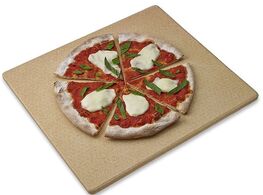 To make a good crust, you really need a rectangular pizza stone... or better yet, a baking steel. A baking steel transfers heat to the crust or pan much more quickly. The size should be at least a 16" rectangular or square to make virtually any type or shape of pizza (or bread). Round stones are limited and difficult to slide loaded doughs onto without overshooting and dropping dough over the back edge. A rectangular stone/steel can efficiently bake pan pizzas, regardless of shape. Remember to preheat your stone in the oven before baking. With a baking steel, preheat for 45 minutes to an hour before baking. Baking pan pizzas on a pizza steel or stone a stone affords shorter bake times and a crispier bottom crust. Placing a pizza in a metal pan directly on a stone speeds up the transfer of heat from the stone to the pan. On a rack, the air in between the rack's wires insulates most of the metal and slows down this transfer of heat from the rack to the pan. TIP: A dark pan will brown your pizza faster, brown better and gives a crispier bottom crust. 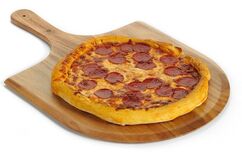 You should also pick up a pizza peel to prep your pizzas on and to remove pizzas from your oven. You might have seen a TV pizzaiolo on occasion loading up their dough rounds with toppings right on their floured, marble work surface, and then drag it onto a peel. Don't even try this. Your dough could stick, you could tear it and heavier toppings will go all over the place. (Because of the way it's made, commercially made dough is often tougher than home-made, artisan pizza, which can be very delicate.) Also, don't be tempted to toss your pizza round up in the air. This is a very advanced skill that requires technique and a stronger dough. While I shape my pizzas on a wooden peel I use a metal peel to remove them from the oven. if space is a premium in your cucina, a wooden one can also do double duty. If you plan on using a wooden peel to remove your pizzas form the oven, select one with a longer handle to make lifting heavily topped pizzas more manageable and make sure it has a tapered front edge. In my opinion, a long handled metal peel for removing pies from the oven is a lot easier to slide under finished, loaded pies. For most kitchens, a 30" long peel will do fine. TIP: In case you have a small, galley style kitchen, make sure you have room to back a long handled peel in or out of the oven before buying one!  When planning to bake pizzas directly on the stone, I recommend using parchment paper on top of your wood peel when shaping your dough. The process: cover your wood peel with parchment; after kneading the dough on your work counter, shape the dough on top of the parchment; next, add the toppings. An alternative method is to shape your pizza round on the work counter on top of a sheet of parchment, then slide the round and parchment onto your peel. Parchment does two things: It helps slide your pizza (with the parchment underneath) onto the baking stone (even with heavily loaded pies); and it helps keep your stone and oven clean. When I first started making pizzas, I used to use stone ground corn meal on the wooden peel (some use flour). You can do this, but I've found that some always falls into the oven itself, gets burned and makes a mess on both the oven and stone.
 For serving, buy flat, round 16-18" pizza serving pans (the larger size can also fit 16" rectangular pizzas with a little ovehang). Do not use this type of pan to bake pizzas on, simply because they are usually silver and won't crisp a crust bottom that well.  You might also consider a large wooden pizza serving board for serving--and cutting--your pizzas on. Finally, don't forget to buy a decent, large diameter pizza wheel (cutter). 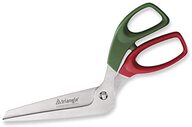 Another good addition to your pizza toolkit is a pair of pizza shears. Common kitchen shears are too short, plus its best to have offset blades for slipping under loaded pizzas. When making pan pizzas, a pizza wheel can cut across the pie, but a scissor can be used to go back and cut the edges the wheel missed.
--Jerry Finzi You might also be interested in:
My Recipe for Pizza Rustica, or Double Crust Pizza Our Secrets for Making a Great Pizza Sauce A Brief History of Wood Fired Ovens Some people called my Dad acting "silly" as a negative, but not me. Anything silly, I love. Something offbeat, oddball, out of the norm, and I'm automatically drawn to it. The time Dad wore vampire teeth at a fancy wedding's cocktail hour was wonderful. My discovery of this interesting pizza is also wonderful: pizza scima ("silly pizza") from the cucina povera traditions of Abruzzo. It's authentic and offbeat. Why is it called "silly"? To understand the name, we have to get into the evolution of the Abruzzese dialect word "scima". This is an unleavened bread, and the Italian word azzimo (masculine) or azzima (feminine) in Italian means unleavened, referring to any bread that's made without yeast. In dialect the word is ascime. Southern Italians tend to shorten words, in this case the word was simplified to scima (SHEE-ma). Scema in Italian can mean either stupid or silly, perhaps in this case referring to someone silly enough to make bread without leavening... The history of this pizza evolved from the 13th century Jews who settled in Abruzzo and made unleavened bread. Traditionally it is baked directly on an open wood fired hearth, common in many country homes even today. After coming up to temperature, the wood coals are cleared to the sides and the dough round is placed directly on the brick base. Next, the dough is covered with a 5" tall dark steel coppo (like a large pot cover) and coal embers are placed on top. This baking method is similar to the Colonial American method of baking bread in a cast iron Dutch oven in an open fireplace. The baking method below tries to mimic the open hearth by baking on a pre-heated pizza stone (to cook the bottom) with a dark pan placed over the top of the pizza (to create a moist, but hot baking environment). You might even try to make this pizza using a baking cloche. Common in the southern towns of Casoli, Roccascalegna, Altino, Lanciano and San Vito Chietino, this pizza is characterized by the addition of extra virgin olive oil and wine. Each year there is even a pizza scima sagra (food festival) in Casoli. Ingredients
Instructions
Useful Tools on Amazon... This year we decided to make our Pizzagaina recipe once again. We loaded up my Kindle with our recipe on GrandVoyageItaly.com and got started getting the ingredients together. As usual, my son Lucas helped with the mise en place. He is a great sous chef but nowadays is also cooking a lot of his own dishes.
With the coronavirus limitations of shopping, and certain things in our fridge missing, we decided to use up some smoked gruyere in place of the mozzarella but still used ricotta and fontina (I love its creaminess). That's the way of the Italian cucina--not letting anything go to waste. Otherwise, our recipe was the same. And each time I make this treat, I'm amazed that I got the ingredients perfectly proportioned--a difficult thing to do when writing up a recipe for other people to duplicate. This crust is just wonderful to work with and fits the spring pan perfectly, with even a little left over after making the lattice strips. In the end, we made the pizzagaina a couple of days after Easter since we had a huge ham that we baked for Easter dinner, along with roasted potatoes, carrots and onions and garlic, along with home made apple and cranberry sauce. There was plenty of leftover ham for soup, sandwiches and the pizzagaina. Try this recipe if you get a chance. If you prefer a more solid filling, add two more eggs when making the filling. Buon apettito! --Jerry Finzi  Continued from Part 1... Finzi: Of course, we’ve read your new book, Ciao Italia: My Lifelong Food Adventures in Italy. You've given us all some more great recipes and stories with an enormous degree of detail. Another winner, for sure. Brava, Maestra! Speaking from an Italian-American perspective, what are the main differences between Italian cuisine and the dishes Italian-Americans served here? And regardless of their lack of authenticity, which Italian-American dishes do you really love? Mary Ann: Regional dishes are based on local ingredients, fresh ingredients and simple preparation. Italian-American food is often based on many canned foods like beans and prepared tomato sauces and inferior, imitation cheese. Of course I love spaghetti and meatballs and chicken “parm” like anyone else. Finzi: I grow our own string beans and especially love those yard-long heirloom beans that can plate like a green spaghetti, but I'll have to take your advice and start growing my own beans. We do make our own sauces from scratch, but most of the year used high quality canned tomatoes. In summer we do make fresh tomato sauce, which is wonderful. Chicken “parm” is a favorite in our house, too. We love the way my wife makes it (casserole style with rigatoni) but I also make a lighter version more like a standalone corso secondo. All of us have our favorite cookbooks. We have a collection of yours (of course), but also from Julia Child, Nick Malgieri, Marcella Hazan and Pierre Franey. Which cookbooks couldn’t you live without? Also, what are some historic cookbooks you would recommend for people wanting to explore the history of Italian cuisine? Mary Ann: Ada Boni’s, Italian Cooking; Waverly Root, The Food of Italy; John Keahy, Seeking Sicily; Carol Field, The Italian Baker; Pellegrino Artusi, The Science in the Kitchen and The Art of Eating Well Finzi: We actually have one on your list--Carol Field’s Italian Baker is amazing and includes a fantastic recipe for focaccia. What regions—or towns—have you never visited or cooked in when traveling through Italy? Which are on your bucket list, and why? Mary Ann: I have never cooked in Friuli or Calabria and I would love to cook in Abruzzo because the food is very high quality, and I love the way they use almonds in cooking. Although I love the confetti (candy coated almonds), there is so much more to do with them. Fried Fish Fillets with Parmesan and Almond Coating 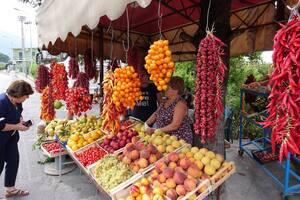 Shopping in an Italian market Shopping in an Italian market Finzi: We agree totally. We love the flavor of almonds in all manner of pastries. But to be honest, I personally never went for confetti almonds—I was always worried about breaking a tooth! The waves of Italian Diaspora during the 19th and 20th centuries brought Italian migration to several countries around the world, merging Italian cuisine with that of their host countries. Have you ever thought of exploring the evolution of this mash-up of culinary cultures? (Examples: Brazil, Argentina, Australia, Tunisia). Mary Ann: It is a great idea and I have thought of it. It's on our bucket list! Finzi: I’ll be looking forward to see what you come up with. By the way, in researching my own surname’s roots, I have discovered that there are nearly as many Finzi in Brazil as in Italy! I’m in touch with many of them via Facebook—perhaps I’ll ask them for some fusion Italian-Brazilian family recipes! Are there any other countries you like to visit and cuisines you enjoy cooking? A fusion, perhaps? Mary Ann: I just love Ireland and their food is fantastic. I also enjoy cooking Chinese food. Click the photo above to see our own Shepherd's Pie Recipe 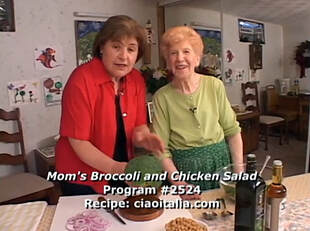 Mary Ann and her Mom cook together in this classic episode. Click to see the video. Mary Ann and her Mom cook together in this classic episode. Click to see the video. Finzi: This past Saint Patrick’s Day, I made my annual shepherd’s pie and my wife Lisa made her Irish Soda bread. Although my wife Lisa makes fantastic Chinese food, she hasn’t picked up her wok in a while. (Hint, hint.) There is such a wealth of ethic food in the world and so many influences in the regional foods of Italy! You’ve cooked with many famous chefs over the years, but we also appreciate when you cook along with home cooks here and in Italy (I still remember the episode with your Mom). Have you thought of doing a series of shows where you feature these home cooks’ recipes? Mary Ann: We have featured many home cooks and you will see them on our new season coming this spring. I learn a lot from them. Finzi: My mother was a pretty good Italian cook and my Dad worked as a grocer and deli man his whole life. Because of this, my favorite heirlooms from them is Mom’s scolapasta, her large pasta pot, her ravioli pin, Dad’s meat slicer and even his retractable crayon marker he used to mark prices on cold cuts. Which kitchen heirlooms do you treasure? Mary Ann: My nonna Saporito’s 2 ft long, thin rolling pin, her cleaver, chitarra, my mother’s scribbled notebooks on Italian foods, her apron and old cannoli forms made out of bamboo. Finzi: Bamboo cannoli forms? I love the idea. Easy to make if you have a neighbor with overgrown patch of bamboo. Beside heirloom kitchen tools, my Mom left me her techniques of making “Sunday gravy”, gnocchi (click for RECIPE) with a fork and her Italian style Pot Roast (click for RECIPE). Dad taught me how to make giant deli meatballs (click for RECIPE) Thanksgiving turkey, Christmas ham and all about home grown heirloom tomatoes. What are the most important technique your family's cooks passed along to you? Mary Ann: Use your hands! They are your best tools. Finzi: According to my son, my pizzas and other dishes are so good that he’d like to see me open a pizzeria or restaurant, but I simply enjoy cooking for my family and friends. With both of your grandmothers cooking for professional reasons, did you ever consider “going pro” and perhaps opening your own restaurant? If “no”, why not? Personally, I would really enjoy dining in your Trattoria Ciao Italia! Mary Ann: No, because I think of my show, Ciao Italia! as my restaurant. Opening a restaurant means a commitment to be there and I cannot do both at the same time. Finzi: Last summer, we vacationed in Cape Ann, Massachusetts and seemed to discover Italian influences just about everywhere. When we visited the North End of Boston we considered it to be a better Little Italy than Manhattan’s Little Italy, the Bronx’s Arthur Avenue or Philly’s Italian Market district. Which “Little Italys” have you visited and what are the best features of each? Mary Ann: I've been to most: Boston, Philadelphia, San Diego, New Orleans. Philadelphia has retained more authenticity; the rest are fading examples. Copyright, 2020 - Jerry Finzi/GrandVoyageItaly.com - All Rights Reserved
Not to be reproduced in any form without expressed, written permission. In Italy, there is a saying, "buono come il pane"... or, "It's as good as bread". This saying is used to compliment the best cooking. Think about it... that's how high Italians value a food as simple as bread, to compare other meals to it. You can't get simpler or better than the humble panino... During our Voyage throughout Italy, one of the simplest and affordable lunches was the panino. Most types of eating establishments have them: the trattoria, pizzeria, ristorante, osteria, taverna, tavola calda (a sort of Italian fast food shop) or bar (all bars are open for breakfast or lunch). In a tavola calda (literally, cold table) might include a wide range of lunch options, both sandwich style and stuffed. A new type is called a paninoteca, which is a shop dedicated to panini and typically open only in the middle of the day for lunch. They are designed as a grab-and-go place, but many will have a few tables. In tourist areas, the restaurants tend to overcharge, but a panino was always an affordable and very satisfying option. In mornings, we also would stop in the local alimentari (like a corner deli) and pick up some cold cuts, cheese and bread to make our own panini while on the road. 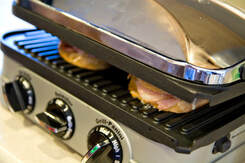 One of our favorite (and most used) kitchen appliances is our panino press, the Cuisinart GR-4N 5-in-1 Griddler. We've had ours for about 5 years and it's still in perfect condition (the plates are non-stick and clean well). You can't beat their low price, either. We use the flat platens for making pancakes and switch to the ridged grill plates to make panini. We buy ciabatta with olive oil from the supermarket and can make a couple of fantastic panini in about 5 minutes. One of our favorite ways to make a panino is to slice up some supermarket mozarella-salame rolls (some brands market these cheese rolls as "panino") along with slices of heirloom tomatoes on ciabatta. Set the panino press on high, give it a press for a few minutes and we're back in Tuscany! A Short Panino History The word "panino" literally means "little breads". In Latin, panis means bread. A panino doesn't really need to be heated, as in Italy it is often eaten as a quick snack on the run, in the field, or in the case of an Italian bachelor.... "Ehi! Mamma, make me a snack!" Stuff some peppers and ham inside a small bread roll and Mama gives her big "bambino" a satisfying, quick snack without much effort. (She thinks, "After he gets married, HE is going to look after ME.") This type more precisely is called a panino imbottito, literally "stuffed little bread". Basically it's the same as any American "hero", "hoagie" or deli sandwich. Similar to a panino is the tramezzino, a grilled/pressed sandwich made with slices of hearty white bread, sliced diagonally with the edge crusts removed. If you want a sandwich in an Italian bar, they will ask if you want it "da riscaldere" or "riscaldo" (reheated), "alla piastra" (literally, on the plates), then they will usually place the panino onto a press in between two flat platens, although many will use ridged ones. Throughout early history, bread was considered an entire meal, until it became the support (think foccacia or pizza) or container for a condiment or filling--the sandwich. Historians have found recipes for grilled sandwiches in cookbooks from the ancient Romans and it is belived that sandwiches were common across many ancient cultures. (Take that, Earl of Sandwich!) The bread in the photo above recreates a Roman bread, baked pre-cut into wedges (to pull-apart) and with a string tied around its waist to create a division to help pull the bread apart into two halves. The reason? To put fillings between the slices, what else? In hotos of carbonized breads found in the ruins of Pompeii, while the top was pre-sliced, the bottom half was not. Perhaps they could alternately use the bottom as a support (an edible plate) for fillings? The first reference of a panino appeared in a 16th-century Italian cookbook, with the first mention of "panini" appearing in 1954 in the New York Times in an article about an Italian festival in Harlem: "The visitors ate Italian sausage, also pizze fritta, zeppole, calzone, torrone, panini, pepperoni, and taralli." Panini as we know them today, became trendy in Milanese bars, called paninoteche, in the 1970s and 1980s. In fact, in Italy during the Eighties, a cultural fad developed in Milano where teens would meet in panino bars,... the teens were called paninnare. In Sicily, Panini cresciuti ("grown rolls") are fried Sicilian potato rolls containing ham and cheese. Today in Italy, shops that specialize in panini are called panineria, although many of these have morphed into offering a smörgåsbord of many types of sandwiches, not just the classic panino. In Italy, sandwich shops traditionally wrap the bottom of a panino in a sheet of white paper, a way to keep hands clean, making this a true finger food. It couldn't be simpler... 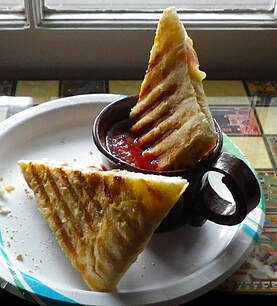 This time I made our panini with slices of salami-mozzarella roll (Boar's Head brand "Panino" roll is nice and spicy, and they also have a Prosciutto version). I find so-called "panino rolls" are becoming a commonplace item in the supermarket fresh cheese section. I learned in Italy that some of the best things can be very simple. This lunch is a good example of this philosophy. Quick, healthy, simple. You can also get more creative too... using grated cheeses like fontina, asiago, smoked gouda or cacciacavalo and using leftover chicken, prosciutto, sausage, caramelized onions, olives, peppers... whatever. (I love making a panino using leftover chicken parmesan!) I highly recommend using a bit of smoked cheese which adds tons of flavor. Today's panino, however, was an ad hoc, simple lunch, like the ones I threw together in Italy. I cut the ciabatta in 4 inch long sections the sliced each horizontally and unfolded them to open. I then slice the salami-mozzeralla into slices a bit less than 1/4" thick and lay 4 on each ciabatta. Some say you need to butter the outside of your bread or brush it with olive oil to make grill marks or a crust, but I omit this step, preferring less fat intake. Besides, I tend to buy "olive oil ciabatta", which helps the browning. if you want more browning, feel free to lightly brush some olive oil on the outside of the panino before cooking. Butter is rarely used in Italian cooking and is never spread on bread, so I wouldn't use it. You can drizzle the contents of your panino with a little olive oil or perhaps a good balsamic, or even a decent store bought Italian dressing. I like to add slices of the best tomatoes I have around, adding moisture to my panino. Black olives or other giardinaria (pickled veggies) are also a good choice. My son, Lucas loves sweet pimentos on his. Try spreading some pesto on the bread too! Setting my panini press to "grill" and to high heat, I let it preheat for a couple of minutes and then load the panini (I can only do 2 at a time of this size). I give it a good pressing at the beginning and try to position the bread (front to back... there's a sweet spot) so the press lid sits flat. After about 2-3 minutes, I give a final press--hearing the panini sizzle. I hold this press for about 30-40 seconds, pull them out, plate them and slice diagonally into triangles. With panini, the longer you press it and hear the ingredients sizzle, the more crunch you will have in your bread. Too many people think a panini is buttered and grilled bread with cold cuts put inside unheated, and many restaurants order packaged sandwich bread with grill marks factory-burned into their crusts, then use it to make make a normal sandwich, calling it a panini. I've even seen sliced factory "panini bread" with the "grill" marks already there. Shame! A true grilled panino must be pressed and heated to meld the ingredients (that's meld, not melt) into one cohesive, gooey mess of deliciousness. And take note, if you use cold cuts and sliced cheese, the cheese must be placed both on top and on the bottom--the melted cheese helps hold the bread together. A grilled panini is not like a normal sandwich... you should not be able to lift the bread off after it's been pressed and cooked. That is, unless you're in Italy, where most basic sandwiches are known as "panini". What I make is a grilled panino. So, get yourself a panino press (no need for an expensive one) and start cooking. Buon appitito! --Jerry Finzi Frank Pepe Pizzeria Napoletana is one of the oldest and best-known pizzerias in the United States. Known by locals as simply Pepe’s, its original location is in the Wooster Square neighborhood of New Haven, CT. 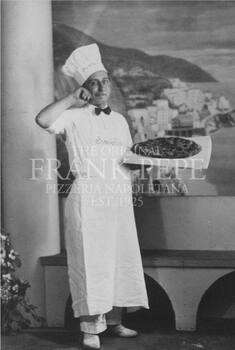 This Connecticut landmark pizzeria was founded in 1925 by Frank Pepe, born in the Amalfi Coast town of Maiori in 1893. As a poor, illiterate immigrant, he came to the U.S. when he was 16 years old and managed to get a job at a New Haven factory until World War I broke out when he returned to his homeland to fight in defense of Italy. After the war he married Filomena Volpi in Maiori and returned to America to start their new lives. Frank at first worked for Genneroso Muro's macaroni shop and next for Bread baker, Tony Apicella where he fell in love with and learned the art of making bread. Once he had learned the art of bread-making, he opened his own bakery at the original Wooster Street location where Frank Pepe’s the Spot (operated by the Boccamiello family) sits today. At first he started delivering bread to his customers, but because of his lack of reading and writing skills, he found it difficult to keep the addresses in order. What to do? Invent a business where the customers come to you. His wife Filomena had learned to read and write which helped enormously for their next adventure... in 1925 they decided to start making something very new to Americans--Pizza! The local Italian-Americans, still today, call it "ah-BEETZ". They offered two types: Tomato Pie with grated cheese, garlic, oregano and olive oil and a second with anchovy. Their "Original Tomato Pie" is still offered at the 157 Wooster Street location, as well as at the others. Keep in mind, however, Pepe's Tomato Pie is thin-crusted and round, very unlike the Philadephia/Trenton are Tomato Pie which is thick, bready and square. 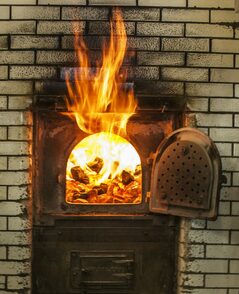 Frank Pepe originated the New Haven-style, thin crust pizza baked in brick ovens fired by coke, a byproduct of coal. In the late 1960’s coke became unavailable, so he converted the ovens to being coal fired, which gives a very distinct, smokey quality to the darker parts of the crust. As time went on, Pepe's developed another signature pizza, the White Clam Pizza. This later innovation was an homage to Frank Pepe having originally served raw little neck clams on the half shell from Rhode Island as an appetizer. Today, it's one of the most popular choices on their menu. If you are a confessed pizza addict and want to eat a little bit of pizza history, stop at a Frank Pepe's Pizzeria... there are locations from Yonkers, NY throughout Connecticut and all the way Chestnut Hill just west of Boston. --Jerry Finzi Copyright 2019 Jerry Finzi/GrandVoyageItaly.com - All rights reserved. Article not for reproduction without expressed permission. |
Archives
July 2023
Categories
All
|

